#one of the reasons I began to draw manga style
Explore tagged Tumblr posts
Text
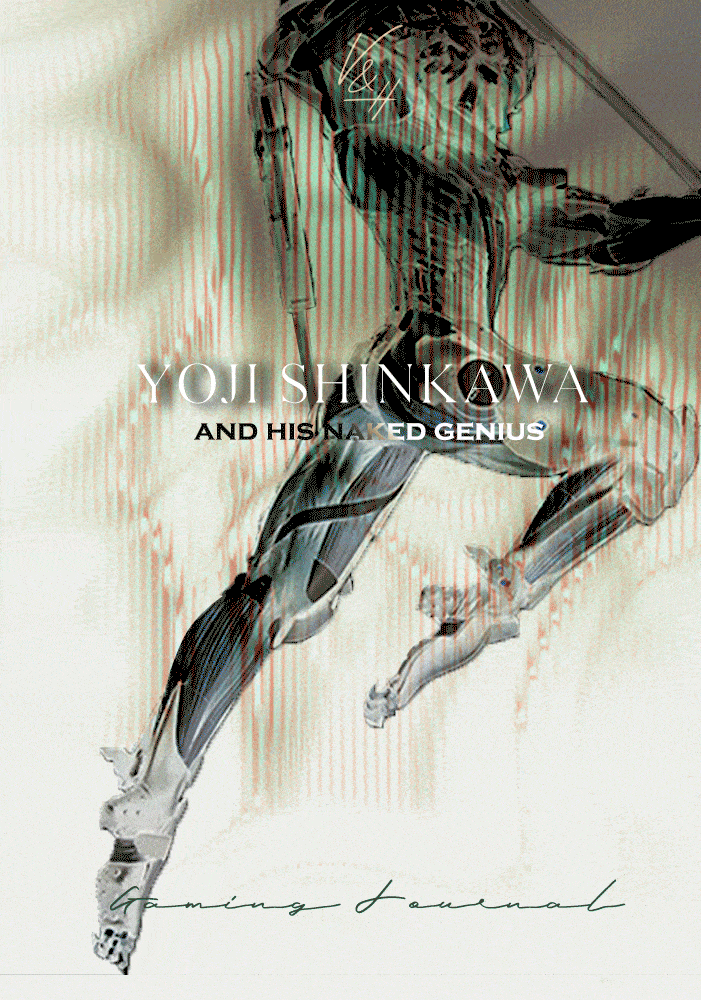
One of my friends asked me by what criteria I choose games. I said there should be a pretty male character. He continued: "Of course, but what else besides a handsome man can you be captivated by the game?" No, my friend, you don't understand. A handsome character is often the only reason I pick up a game. I'm not saying that this is the only thing that defines for me such a complex work as a video game. But it is futile to deny the fact that we are living beings who like beautiful things and especially attractive bodies. Yoji Shinkawa understands this too. As well as the fact that the player spends most of his time looking at the protagonist's back. So why not make that back as attractive as possible?

At around the age of 19, Yoji Shinkawa entered Seika University in Kyoto. It is a private university known for its manga and anime departments, often taught by mangakas. Young Shinkawa's passion for art blossomed as he got acquainted with the books of his compatriots, illustrators Hikozo Ito (1904 - 2004) and Kashō Takabatake (1888 - 1966). Both graphics, the theme of a warrior is present in the works of both. As a technique, Shinkawa first chose gel pens. According to him, the reason he started using his brush pens was because of the influence of Yoshikazu Yasuhiko. In junior high school Shinkawa read a book on how to draw manga and tried using a dip pen, which turned out to be a failed attempt.
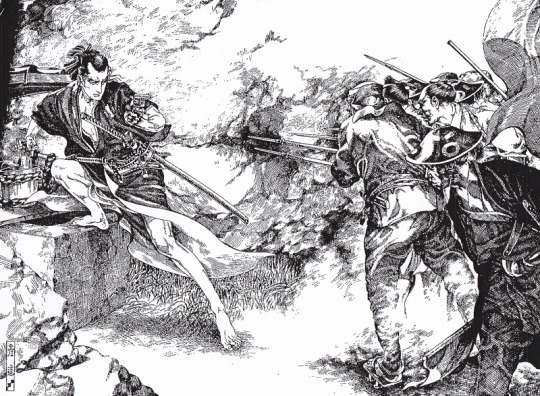
Kakubei Jishi (written by Jiro Osaragi). Illustration for a Shonen Club serialized novel. Hikozo Ito, 1927
His desire can be understood. Drawing with a dip pen allows to create things of incredible sophistication and detail. Just look at drawings of another Shinkawa's inspirator Hikozo Ito. How detailed his works are, how accurately he conveys the mood and characters of the heroes on his works. No wonder they made an impression on Shinkawa. In further practice, he began to use a brush pen, which brought the future designer closer to the technique of his teachers Yoshitaka Amano and already mentioned Yasuhiko, who drew with brushes. Already at a young age, Shinkawa began creating his own illustrations for anime magazines.

After graduating from university in 1994, Shinkawa began working at Konami, one of the leading video game developers and publishers. Here he meets the game designer Hideo Kojima, whose brilliant star has yet to shine on the gaming industry. Maybe it wouldn't shine so brightly if it weren't for Shinkawa. The person who gave birth to a brilliant idea met the person who breathed life into this idea with his brush. One of the first projects that Shinkawa worked on was the game Policenauts, created by Kojima. In this work, one feels that he is still on the way to developing his style - his drawing is similar to anime and manga and lacks any personalized features.
At the same time, in 1995, under the direction of Kojima, Shinkawa began working on his Metal Gear Solid project. Significant changes in Shinkava's style are felt in the work on this project. Almost not a trace remains of the bright anime drawing from Policenauts. The design feels more grim, the characters themselves look more "western" than most Japanese games of the time. As Shinkawa himself noted, Kojima has provided complete creative freedom. The designer only described the intended characters to him in general terms, often indicating only the gender itself. This approach took more time to develop, but at the same time, freed Shinkawa's hands both as an artist and as a designer.
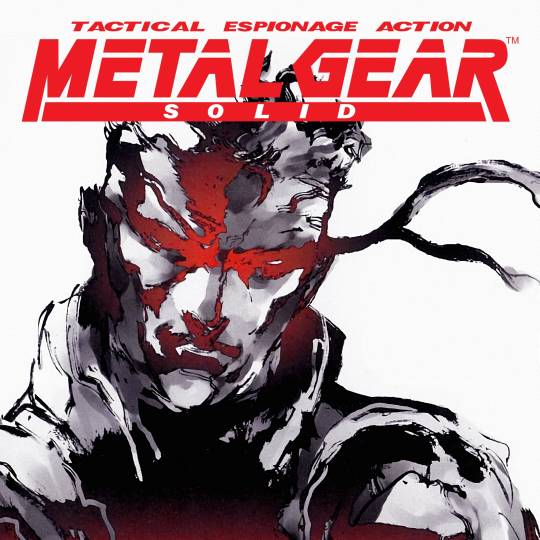
Design, no matter how many beautiful things it creates, is a utilitarian thing. It is not enough to draw 'pretty'. Your work should have practical significance. In the case of video games, character design is about creating an image that is easily remembered in the player's imagination and makes the hero unique. This uniqueness comes from the features of the character itself: his occupation, character, role in the game, relationships with other characters, etc. With space for imagination, Shinkawa tells their story directly on paper, conveying it in poses, clothes, facial expressions and the way their bodies are composed. In the world of Metal Gear, the player is constantly on the battlefield. The main activity of the characters is focused on their confrontation, so they must be in good physical shape. And Shinkawa emphasizes this in every possible way.
The figure of young Solid Snake, the protagonist of Metal Gear Solid, is very stable and tense, but not without flexibility. Shinkawa's line breaks like waves, drawing the relief of the body under the baggy suit. By adding colors on the computer, Shinkawa creates three-dimensional shapes that convey the roundness of muscles. Snake's entire body is covered. But even under the folds of a tight suit, you can see a well-built body.

Notice that Snake's figure is heavily shaded: you cannot see his face. In the first works, Shinkawa did not draw faces and eyes in detail, because the graphics power of the PlayStation did not allow to reproduce the textures in detail. Shinkawa smooths out the facial features, but you can definitely understand Snake's emotion and character.
Much more interesting and artistically opposite to Snake is the figure of Gray Fox. Shinkawa's vision of a character goes beyond just a form designed to perform a certain function. For Shinkawa, the body is another way to tell a character's story, to reveal his essence before the player discovers more information about the character. This is how the means of artistic expression in art work. Looking at a picture, you subconsciously note the things that the creator put into it. You can't always explain exactly what you see, but you always accurately identify the emotion that excites your mind in the very first second of contemplation.
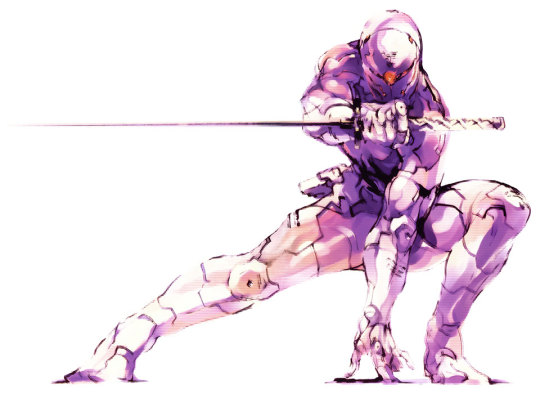
Shinkawa plays with the player's imagination. Gray Fox is a cyborg, but in his image there is not the slightest hint of the artificial nature of his body. It is sculpted by the muscles that transmit the plastic to its exoskeleton. It seems to be pieced together from scraps and feels lighter and more flexible compared to Snake's living body. The designer goes deeper than just trying to convey the image of a ninja literally. He depicts a slender solid silhouette - only a shadow of a mercenary, in which the embedded image of a ninja can be clearly read. A victim of horrific experiments, he hides his mutilated flesh behind a cold cyborg body made in the colors of steel and human flesh. The gaze of the eyes disappears behind the mask with an eerie glint of a red sensor that resembles an eye. Shinkawa does not resort to excessive or even any careful detailing. The designer moves away from unambiguous and finished images. All superfluous and unnecessary details are cut out, leaving the content embodied in a fragile, fleeting form.
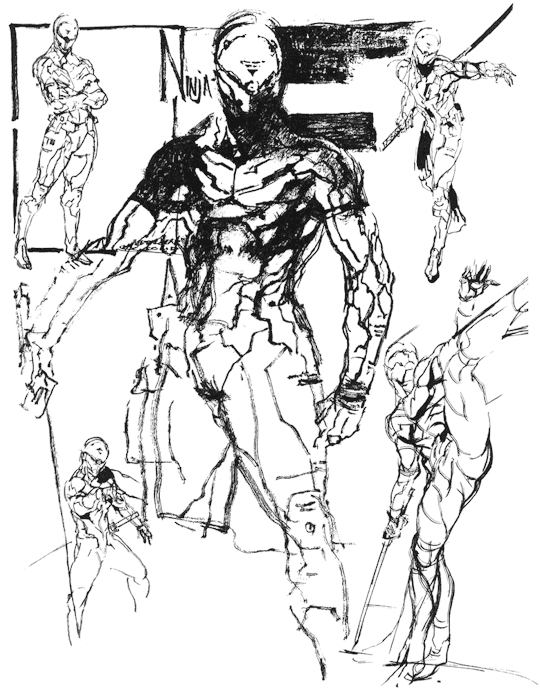
As Shinkawa noted, one of his inspirations is the French artist and author of comics Jean Giraud, better known as Moebius. Giraud is closely related to cinematography. He worked with Ridley Scott on the films Alien (1979) and Blade Runner (1982), created costume design for the cyberpunk film Tron (1982), was involved in the creation of The Fifth Element and many other projects. Although this fact may seem insignificant, it is still quite symbolic in Shinkawa's work. Kojima, with whom the artist created images for games, opened another means of artistic expression for the game industry, including elements of cinematic art in the game, namely cutscenes. Prior to this, narrative was part of the gameplay, presented in the form of long notes or short notes. Cutscenes made it possible to directly connect the gameplay with the story, making the work a single whole.
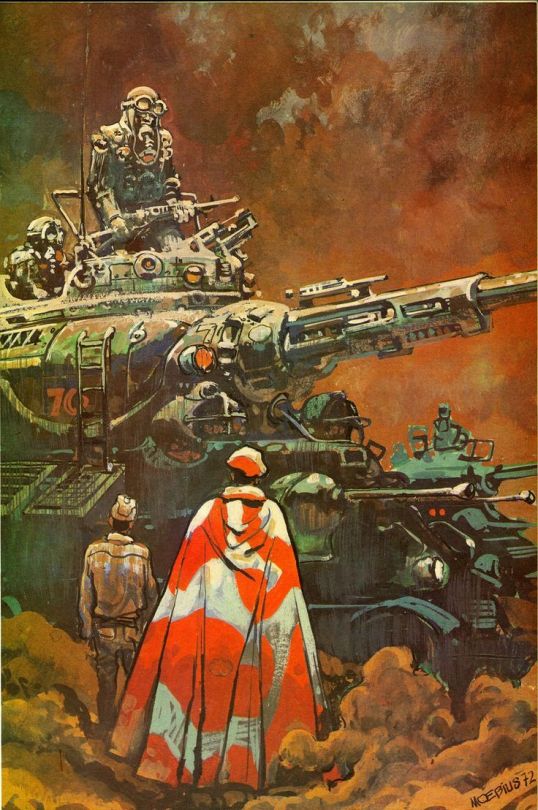
Illustration to Gordon R. Dickson's work Pour quelle guerre. Jean Giraud, 1972.
The large number of cutscenes typical of Kojima's games deliberately create an opportunity to examine the characters from every possible angle, revealing Shinkawa's genius. For the designer, this is a kind of art camera, where his creations are presented in various poses and lit up like curiosities, playing with the player's imagination. When I started playing Metal Gear Rising: Revengeance again recently, this became more apparent than I thought. Alongside cinematic scenes, there are plenty of close-ups with unexpected angles. The characters are not just pleasant to watch. You want to interact with them.
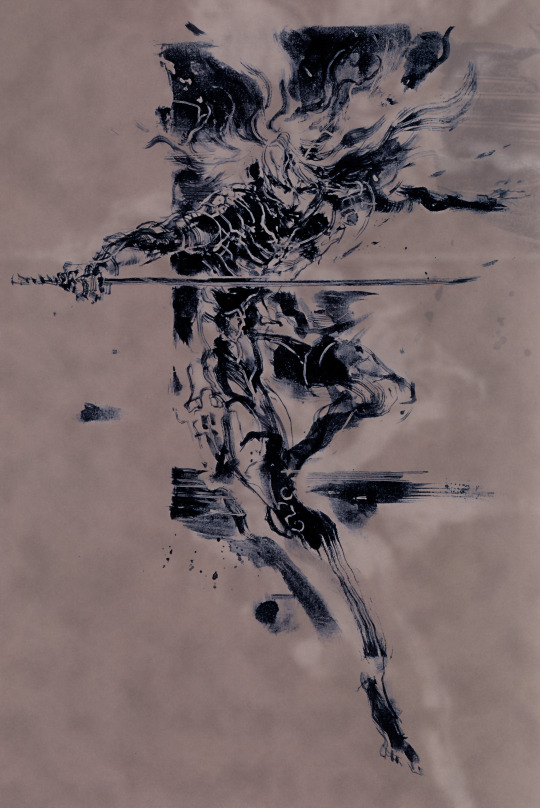
My favorite work of Shinkawa. Stylistically, it is very similar to the works of Yoshitaka Amano: a smooth silhouette that practically melts on the plane of the sheet. The composition is minimalistic, but very meaningful. With one sketch, Shinkawa conveys the character's name (in Japanese mythology, Raiden is the god of lightning), the plasticity of his young body, and the killer's concentrated gaze.
Raiden's design is probably my favorite. He appeared in the franchise with the release of Metal Gear Solid 2: Sons of Liberty in 2001, via a fan letter to Hideo Kojima. Its author complained about the old characters constantly repeating themselves in Metal Gear. In creating the image of Raiden, Shinkawa moved away from the image of a strong, stereotypical male figure, inspired by the popular heroes of the 90s and the American superhero comics from which he took inspiration. The designer resorted to a more Japanese view of male beauty, which was used by the same Kashō Takabatake in his works.
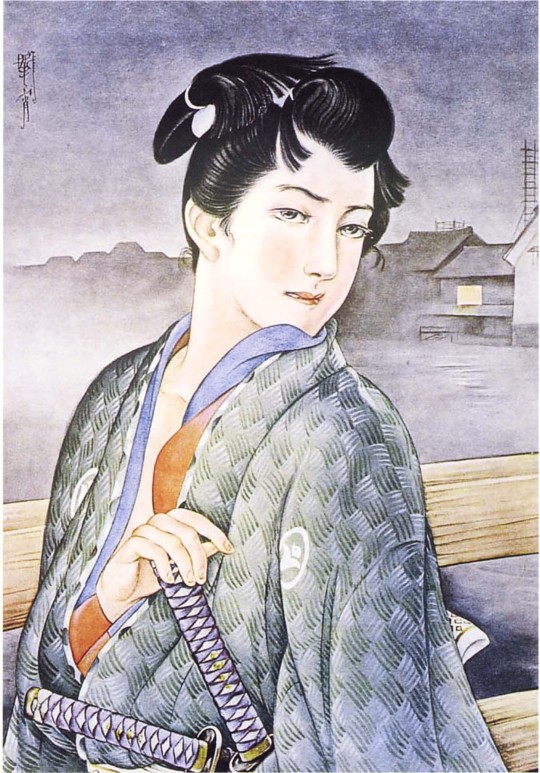
Kashō Takabatake's work on exposition in Takabatake Kasho Taisho Roman Museum. Compare Takabatake's warrior with Hikozo Ito's one. Takabatake created advertisements and illustrated magazines in which the influence of modern is noted. The faces of his soldiers are very gentle and graceful. It was his unique illustrations of beautiful boys (bishōnen) and beautiful girls (bishōjo) that took the world by storm, bringing fame to the artist.
The concept of Bishōnen, or literally from Japanese "beautiful youth (boy)" characterizes not just a man with good looks. In the Japanese view, this is an aesthetic principle that transcends gender and sexual orientation. The roots of this concept stretch back to ancient Chinese literature, the homosocial and homoerotic ideals of the medieval Chinese imperial court, which are found since the Middle Tang Dynasty (~700s). Gradually, this concept penetrated into Japanese and other Asian cultures, and we can observe its examples in the realities of today.
The introduction of such a character did not cause much excitement among fans of the series. Overly refined and too androgynous, Raiden with his silly backstory looked out of place against the muscular Snakes with complicated pasts. However, analyzing Shinkawa's subsequent works for Metal Gear and the gradual change in Raiden's design in particular, it can be assumed that Raiden's image to some extent helped Shinkawa develop more deeply the idea of glorifying physical beauty, born in the image of Gray Fox. On the character concepts for MGS 2, it is noticeable how the designer focuses on anatomy. Raiden's suit fits his body tightly, revealing his supple muscles. Shinkawa leads the line very carefully, it feels taut and elastic, revealing a sculpted form to the viewer. The volume is complemented by the play of light and shadow, which slides along the curves of the figure. To enhance the impression, Shinkawa lengthens the katana, making it more curved to enhance the sense of tension in the composition.
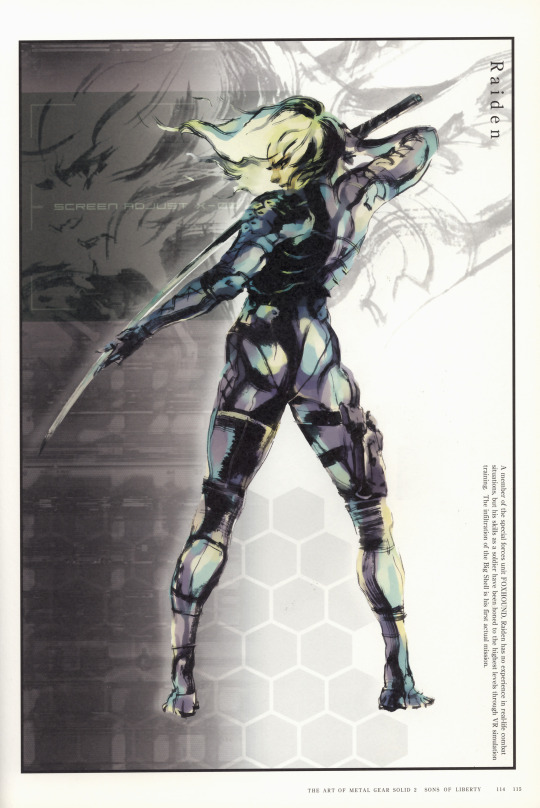
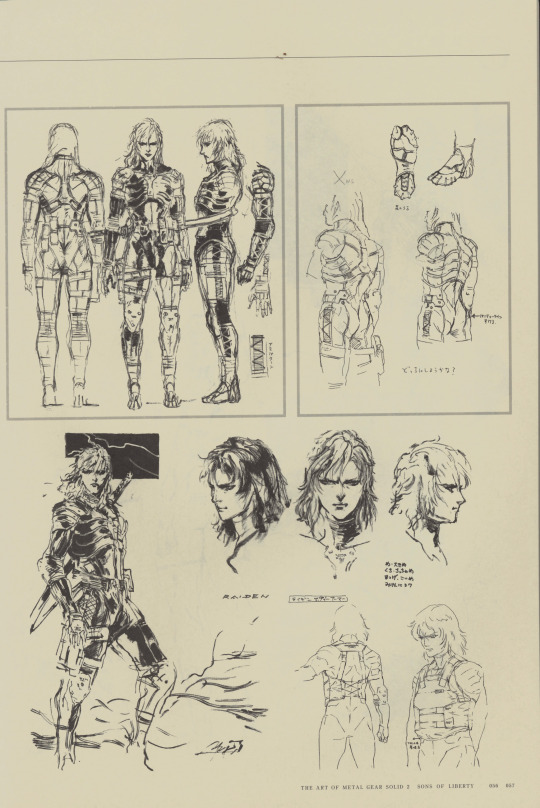
Although we mostly know Raiden today as a cyborg ninja, in the sketches for MGS 2, Shinkawa makes his suit look like samurai armor by adding shoulder and chest plates.
In the work on Metal Gear Rising: Revengeance (2013), Shinkawa continues the chosen path. During this period, the experience and acquisition of one's own style allow the designer to create incredible things according to his artistic solution, twisting the concept of aesthetics to the maximum. The image of Raiden evolves from a fragile young man to a brutal cyborg endowed with superpowers.

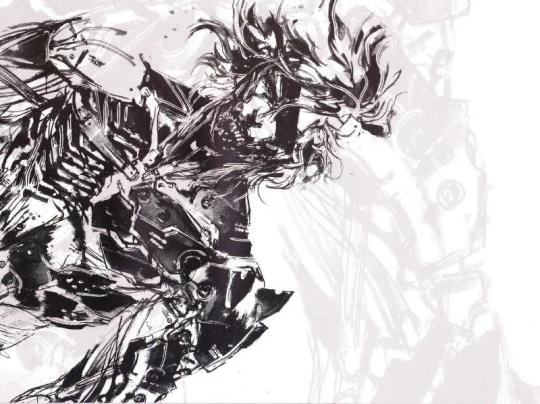
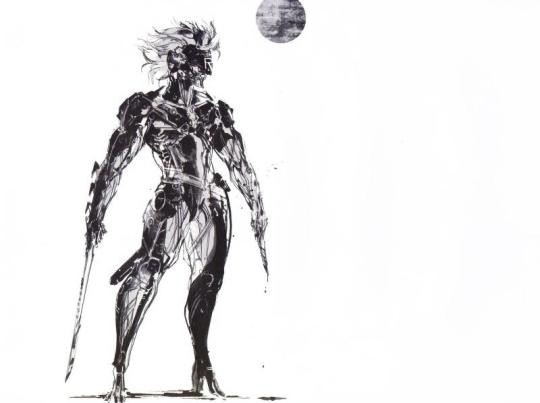
The flexibility of his human body is replaced by the monolithic heaviness of the exoskeleton. Shinkawa abandons the streamlined design used in the image of Gray Fox, which conveyed the ease of movement inherent in a ninja. He appeals to the "pure form", stripping the hero of even his skin as something unnecessary, and turning Raiden into practically a living Écorché (an educational figure showing the muscles of the body without skin). In his desire to get rid of the excess, Shinkawa goes even further. He does not depict a beautiful body, but what makes it beautiful - a skeleton and muscles - the initial form on which everything else is superimposed.
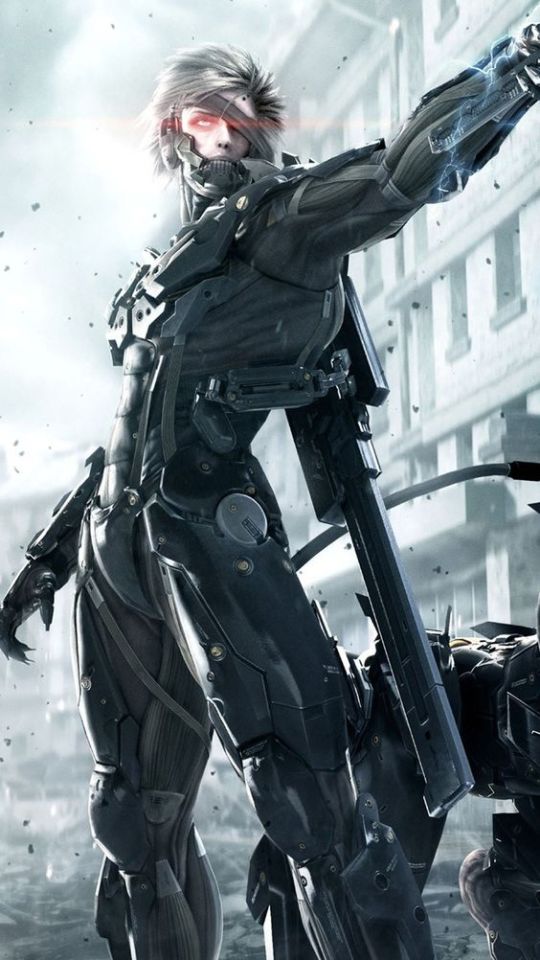
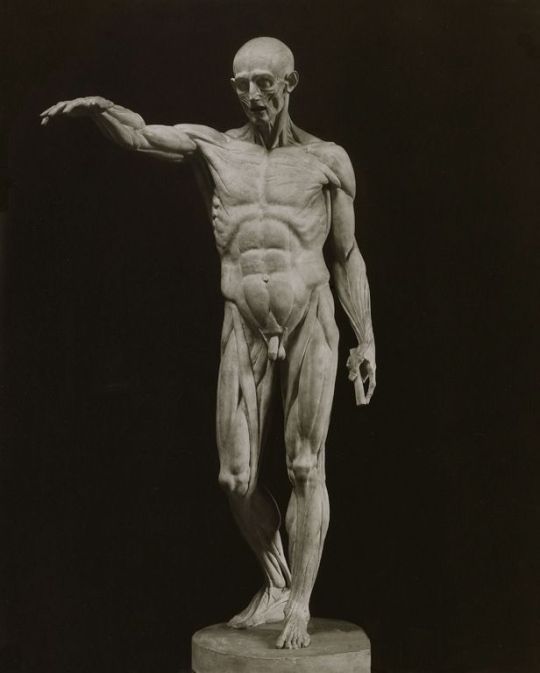
Ecorché. Jean-Antoine Houdon, 1776
Here I should explain what I mean by "pure form". Depicting a simple sketch of a character or creating a complex composition, Shinkawa draws as simply as possible. At the same time, it is important for him to depict not only the design of the character. In the figures of the heroes, attention is drawn not so much to their appearance as to their inner state expressed on their faces. Shinkawa did not specify the details. Characters in rough drawings are perceived as very conventional. Their images are personalized, but conditional.

Eva, Naked Snake, & The Boss. Art to the Metal Gear Solid 3: Snake Eater
Shinkawa avoids unnecessary trifles, preferring empty space. The artist's brush moves almost chaotically, revealing the smallest nuances of the image. With each subsequent game, his technique acquires clear features of traditional Japanese painting. In unfinished, at first glance, ink spills, Japanese artists sought to convey not the appearance of things, but to capture their spirit, to imprint their state or their own impression on the canvas. The artist lays down a minimum of lines and tones sufficient to recognize the form, texture and effects to be felt. Ink spills change in all possible shades of black, the vague outlines of the image make you feel the changeability and fleetingness of the moment.

Screen with pines and bamboo. Tohaku Hasegawa, Nanao Museum of Art, Ishikawa, 17th century
This approach to the image has advantages that could turn into disadvantages for the designer. Since the main point of Japanese painting is not the realistic accuracy of the surrounding world, its reproduction does not require a thorough knowledge of the anatomy or structure of objects. But there is one more thing that I deliberately did not mention before this. Despite the fact that Shinkawa appears as a graphic artist in his design works, he studied oil painting at Seika University. Painting, unlike graphics, is not characterized by vagueness and sketchiness. Shinkawa does not completely get rid of the influence of the acquired equipment. The volume of his figures protrudes beyond the surface of the sheet, creating the illusion of depth. But Sinkawa's best pictorial past can still be felt in his appeal to anatomy as the basis of the physical embodiment of the hero, the transmission of the story behind him. At the same time, Shinkawa's works are almost painterly, with a lot of color strokes, even if he uses only one color. This is a characteristic feature of Japanese painting, the flatness of which the artist transforms to his own needs. Thus, using the ideas of Japanese painting and removing the excess, Shinkawa exposes a pure form. And his experience in oil painting allows him to depict it accurately.

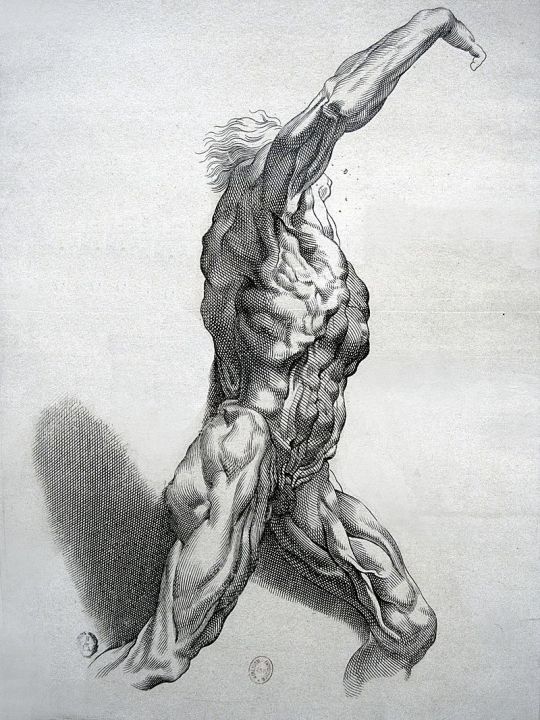
Raiden collectible figure Écorchéchisel. Paulus Pontius,
~1640. Engraving by Rubens
In the concept art for Rising, Shinkawa focused on finding the perfect representation of anatomy that would emphasize the athleticism of the character. From athleticism, in turn, comes sexuality, which Shinkawa instills in robots and cyborgs. Raiden is a killer machine. Even if his blade is an instrument of justice, he himself admits that in order to protect the weak, he kills the strong. His desire for battle, thirst for blood, and pleasure in pain - all find expression in his appearance.

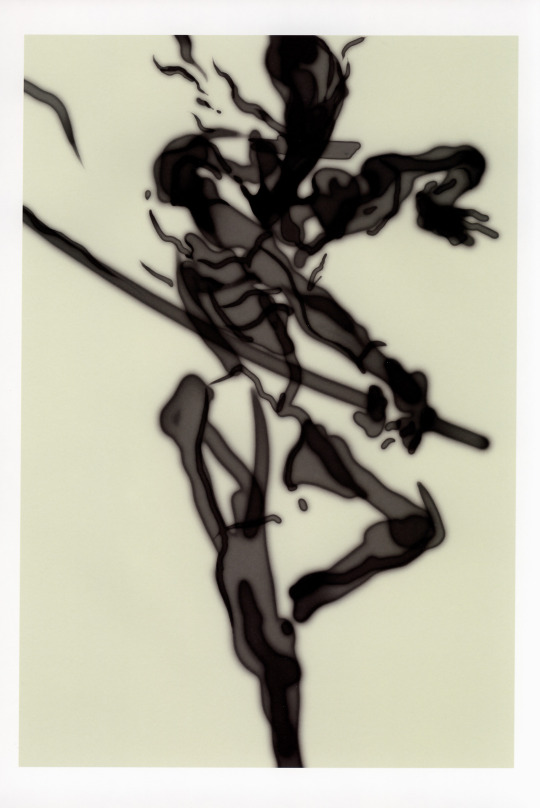
Much more can be said about the work of Yoji Shinkawa. Maybe I would like to do a review on his metal gears themselves, where it's also possible to discover a lot of interesting things. Or about his concepts for Death Stranding and the game itself in general when I finally get through it. In this part, I wanted to share my thoughts on what most touches me in the designer's work.
So yes, it was review on Raiden's butt
Credits:
Metal Gear Solid galleries
The Art of Metal Gear Solid 2: Sons of Liberty
Metal Gear Solid 3: Snake Eater Art
Metal Gear Rising Revengeance Artbook
In the shadow of Kojima: Yoji Shinkawa, designer of Metal Gear Solid and Death Stranding
Gif used for cover image by Erica Anderson
#metal gear#metal gear series#mgs#mgs2#mgs2 sons of liberty#mgs raiden#raiden mgs#mgs2 raiden#mgs3#mgs3 snake eater#metal gear solid 3#mgrr#metal gear rising#metal gear rising revengeance#metal gear raiden#mgs snake#solid snake#metal gear art#yoji shinkawa#shinkawa#japanese art#hideo kojima#kojima#my articles
377 notes
·
View notes
Text
_Art Book of Naruto Uzumaki_ Part-3

This appeared on the front cover of the issue of Weekly Shonen Jump in which the serialization of Naruto began. I mainly wanted to establish that this character is a ninja and convey his personality by doing things like putting a leaf on his head, having him make a hand sign, making him look cheerful...but putting all these elements into one picture ended up making it appear jumbled. Also, I used a coloring pen called a COPIC marker here for the first time, and because I wasn't used to it yet, I colored little by little as if I were using a brush. As a result, the coloring came out oneven.
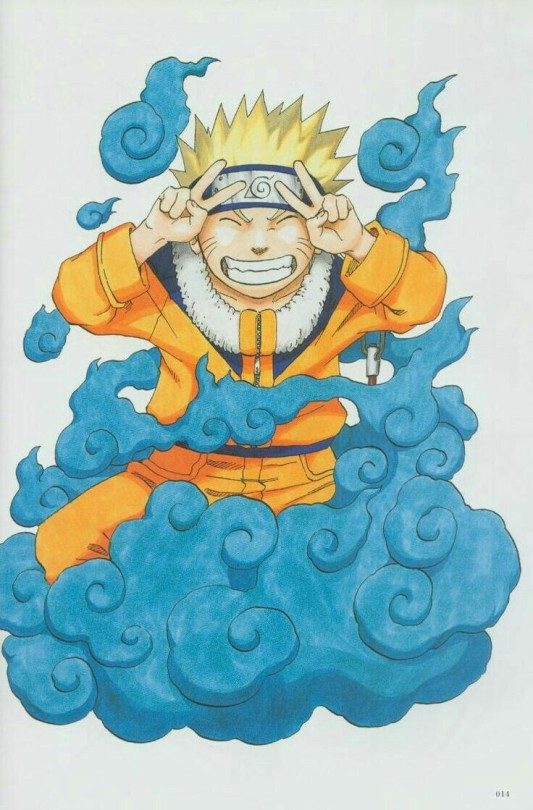
Here's another one I drew for a shonen jump commemorating the second anniversary of the Naruto series. Naruto's making peace signs, but holding up two fingers also represents the number 2, for the second anniversary (laugh). When I was drawing this picture my schedule was so tight that my editor suggested, "Maybe it'd be easier to do a design where Naruto is appearing out of smoke!" As it turned out. It was difficult drawing the right amount of smoke to cover Naruto's body (laugh). I just couldn't decide how much of Naruto should be hidden or visible, or how to show him emerging from the smoke. The bluish color of the smoke was used to make Naruto stand out. I usually use this kind of color scheme so that Naruto's orange outfit will "pop".

In this volume, Tsunade appears along with Jiraya and Orochimaru, and Naruto gets tangled up with them. So I drew those Three Legendary Ninja on the book cover. I put Naruto on the cover became I had to, more than for any other reason (laugh).
I wanted Naruto in some kind of pose, so after some agonizing, I had him make the formal greeting of the yakuza from the movie Jingi. I've seen many of the flims in the Jingi movie series, and I like those kinds of Japanese modes and customs. [ Jingi is a Yakuza series that describes humanity, justice, and moral relationships between a boss and his henchman, or a master and his pupil. ED]

This dragon head actually exists in China.
There's a dragon on top of the roof tiles of the wall of a house or something.
That image was so impressive to me that I wanted to put it on top of a roof, not just a wall.
The top of the roof tiles form the backbone of the dragon, and it connects the dragon's tail and face. Naruto and the other three on the roof are wearing sashes. Naruto's sash ties his sword to his back, and the wind is making all the sashes float on the air.
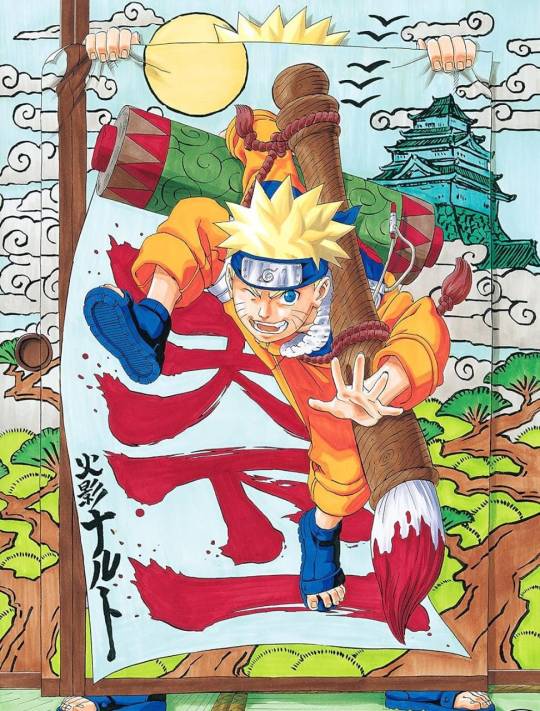
I created this piece based on the catchphrase "Hide your appearance, but don't hide your dream" (the winner of a catchphrase contest held by Weekly Shonen Jump in 2003). Naruto is hidden but his dream is not... I had a really hard time coming up with a composition that would express this idea while sticking to the Naruto style. Boy, this was a handful (laugh). [Naruto's banner reads "Number one under the sun! Hokage Naruto." -Ed.]

I wanted to draw Naruto's hands creating a sign, so l designed this to emphasize his hands. Also, I wanted to show the sign from the side instead of straight on. I like drawing hands, fingers and toes. But they're difficult...and I can't do them very well. Actually, I could've chosen at the beginning to have Naruto wear boots instead of sandals, but I picked sandals because I really wanted to draw toes. It's a major headache for the animators (laugh).

I actually like drawing animals, too. Partially because of Akira Toriyama-sensei's influence on me, I've always felt that a manga artist has to be good at drawing animals. So I've practiced them since junior high school. In this picture, I paid close attention to balancing the layout of the animals. I also wanted to draw some small object to spice up each animal, such as an apron for the dog, a hat for the tanuki (raccoon dog), a bandage for the monkey and a scroll for the weasel. But actually, the bird doesn't have anything... (laugh).
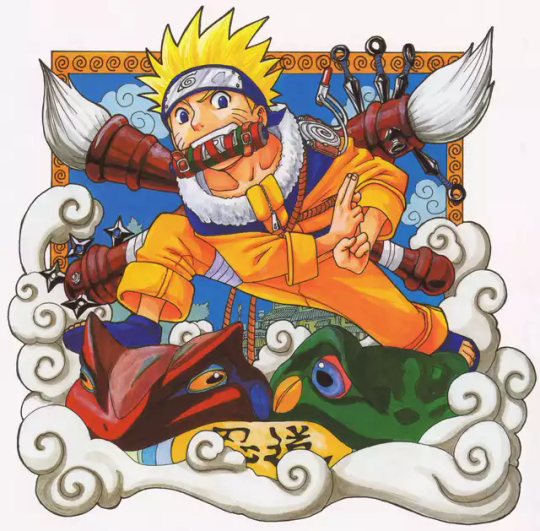
I spent a lot of time drawing this because it was for the cover of the first volume of Naruto. It took me a week just to do the rough draft and about a day and a half to color it. One reason it took so long to color is that I used gouache (a kind of opaque watercolor paint) I had had since college. I personally like gouache because you can use it to give a lot of depth to the colors. I ended up having to redraw the main lines with a precision pen because the paint covered them up. How's that for double work? (laugh).
20 notes
·
View notes
Text
Re: that last reblog
I might get a few raised eyebrows over this but here goes...
TL;DR: Thanks to that post, I'm accepting that I'm not cut out for producing consistent forms of media, internalized ableism might be why, I'm not cancelling Elegy, but Imma just do whatever I want.
Full thing with explanations below, but beware, Imma get personal for a bit, and my experiences with ableism will be mentioned, which...I never really talk about outside of my innermost circles:
In the last several years, I always thought my inability to make comics or games or literally any other form of consistent medias was due to the fact that I "lacked discipline". That was reinforced by the fact that the artists I follow, a couple of my friends, and my fiancee, are all webcomic artists that handle/handled things at a moderately consistent pace. This was also reinforced by shit I was told when I was younger IRL, when my undiscovered neurodivergency was excused by shit like "you're lazy" or "you lack discipline" and other similar statements.
In the last several years, I've tried time and time again to make some consistent medium in which my stories can be told, namely comics and games. I wanted to believe that I was doing it for the love of my stories, but in truth, I was doing it to "improve my discipline", which inevitably, ended in failure time and time and time again, and with each failure, hatred for myself increased, and in the last couple of years....it began to extend to my confidence and my stories. It all ended in one thought to everything: There's something wrong with me.
Recently, I felt like I experienced an artist's existential crisis, thanks to the one-two punch of burnout from doing Elegy Chapter 1 and being slapped with arthritis-related issues: why do I create, am I a good artist, why do I love these stories, is there really a right way to tell a story, do I ACTUALLY love the stories I make?
Well obviously, yes, I do love the stories and worlds I create, but for whatever reason, I genuinely cannot get myself to do anything beyond disjointed art pieces of stuff that would be classified as "spoilers". My followers want something more than that, I thought. They want stories.
But then that post came across my dash, and I felt like I was hit with an epiphany.
For one, I was projecting onto the followers I do have. I know those that truly stick around through my inconsistencies after all these years will love the stuff I create no matter the form or medium, and no matter how out of context it is. I should believe that rather than the imaginary expectations that have been placed on me for years.
Two, it was never about a lack of discipline....I was actively working against my neurodivergent brain, AKA how I function entirely. Of course it wouldn't work! It's like asking a mircowave to be a washing machine! Realizing that lifted a huge weight off my shoulders as both an artist and a person.
Three, I create because I love to. That's it, that's all the reason is! I love the art of creating worlds and weaving stories and writing fun and complex characters, and I love seeing how they all interact and change and influence off each other! The world influences the characters, the character influences the story, the story influences the world.
Soooo, why not draw whatever I want, do whatever I want, and be whatever I want? Out of context sketches and arts and insane ramblings is just as valid as a medium right?
While I do have people who work on webcomics, I also know and follow people who do this exact thing: draw things relating to their story, attach a blurb to said pictures about their worlds and characters in various forms of medium, and nothing more.
So I'm going to try that. Forget the manga....well okay, I might still do smaller comics for funsies, but forget "proper" mediums, Imma do whatever I want, and I know people will love it, no matter the numbers! Gives me a LOT more room to experiment with different styles and mediums and the like!
If you've managed to read this far, thank you, from the bottom of my heart. I do have a terrible relationship with social media and how the internet is nowadays, but I do cherish the followers that have stuck around this far. I wanna do things for y'all, but above all, do things for me.
17 notes
·
View notes
Text
Dragon Ball Super Manga Ch.1-4
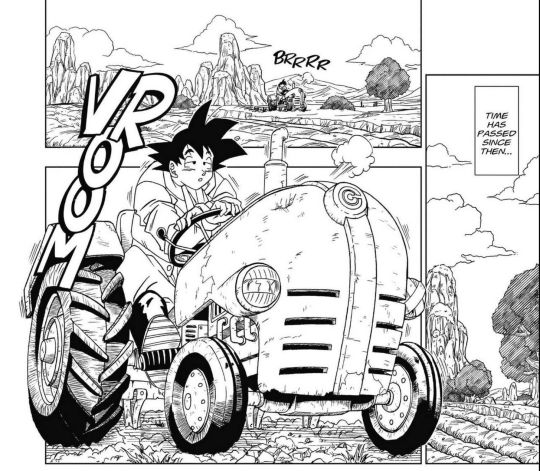
What’s that? Did you think we were done with Battle of Gods? No, we need to go over it a third time.
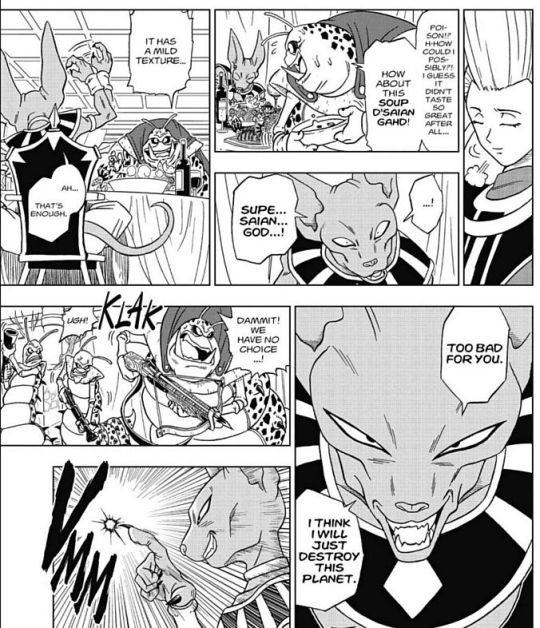
So after the success of the Battle of Gods and Resurrection F movies, Toei began producing the Dragon Ball Super anime, while Shueisha began publishing the Dragon Ball Super manga. Both started up around the summer of 2015, and both made the... uh... bold choice to retell the Battle of Gods movie.
The weird thing is that both versions have significant differences from the original story. They don’t even agree with each other, and I don’t understand what the point of this is. The basic plot points are the same, but the details change. For example, Beerus wakes up in the movie and pretty much heads straight to the North Kai Planet to meet Goku. In the anime, Beerus visits at least one other planet instead, and he decides to only destroy half of it because their food was good, but too greasy. Then he destroys a second planet and the explosion reminds him of the Super Saiyan God premonition.
In the manga, he visits an alien planet, and the locals try to poison his food, but it doesn’t work. One of their dishes is named Soup D’Saian Gahd, which jogs Beerus’ memory of his premonition, and he destroys the entire planet, not just half like he did in the anime.
My whole beef is this: Who is this for? A lot of times, you’ll see a movie come out, and there’ll be a novelization, and maybe a video game, and maybe a comic book or something. They might vary in content, but mostly because not everyone had access to the final script. I’ve heard that in the novelization of Empire Strikes Back, Yoda is described as being blue, probably because the author didn’t know they had picked green when principal photography began.
But the point is that those are different media, with different priorities. With Battle of Gods, we have an animated movie, and animated TV series, and a comic book that resembles the art style of the movie as closely as possible. The implication is that all three need to be the same, and yet they’re frustratingly different in minor, nitpicky ways.
To be sure, the classic Dragon Ball anime and manga had differences, but for a reason. The anime would pad out scenes and invent whole new ones to sustain its production schedule while the manga was being published simultaneously. Here, that doesn’t apply, because you have a TV show and a comic book adapting a two-year-old movie. Also, there seems to be no interest in making both versions agree with each other.
So let’s explain how this works. You see Akira Toriyama’s name listed all over the DBS manga, but his involvement is pretty minimal. When they list him as “author”, they mean he’s the guy who created all the characters. It’s like when they put “Based on Star Trek created by Gene Roddenberry” on every episode of Star Trek. Gene’s been dead for over thirty years, and even before that, it’s not like he was writing all the scripts.
Instead, the DBS manga is written and drawn by Toyotaro, a different artist who was chosen by Toriyama. As I understand it, the formula for Dragon Ball Super is this: Toriyama will come up with a plot outline, then send it to Toyotaro, who expands it into a full story. Toyotaro is an extremely controversial figure in the Dragon Ball fandom, mostly for high crimes such as “drawing the Dragon Ball comic”, and “existing”.
For my part, I gave up on the DBS manga when it became apparent that it wasn’t going to do anything I wasn’t already getting from the anime. But after the anime ended, Toyotaro finally got to tell original stories like the Moro and Granolah arcs, and that’s why I decided to finally read the manga this year. Unfortunately, it means I gotta wade through a bunch of reruns to get to the good stuff.
I suspect Toyotaro was similarly frustrated with this arrangement, because his Battle of Gods adaptation is very short--only four chapters long. And there is no Resurrection F adaptation at all, which is lucky for me. I think Toyotaro was champing at the bit to get this series moving, and in the meantime, he managed to work in some new additions where he could.
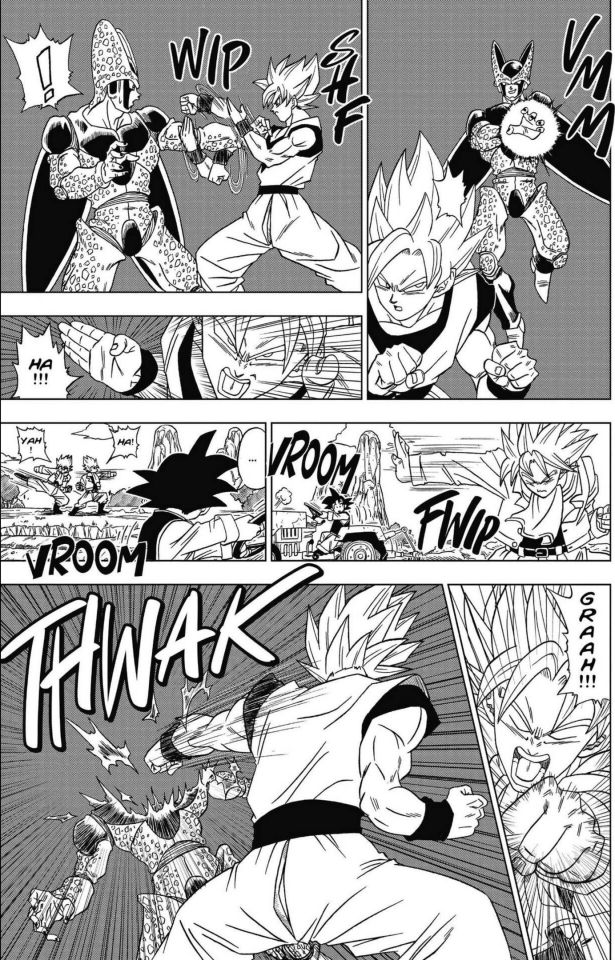
For instance, chapter 1 pretty much follows Goku’s POV from Episode 1 of the anime. We see him doing exercises while Goten drives his tractor, but Toyotaro also shows him imagining his old enemies while he does his drills. This is handy, as it gives Toyotaro an excuse to put Cell in the manga. Also, I find it kind of amusing that Goku’s training regimen is exactly the same thing his real-world fans do on the playground.
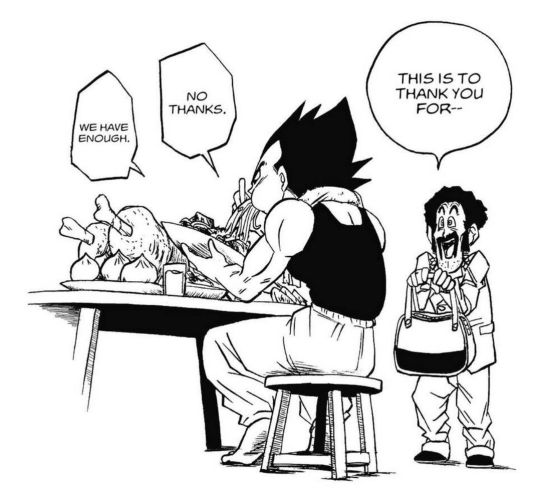
Vegeta is barely in this thing, save for the part where he fights Beerus on Bulma’s cruise ship, so Toyotaro puts in some side panels of the guy, like this one of Mr. Satan trying to give him his award money.
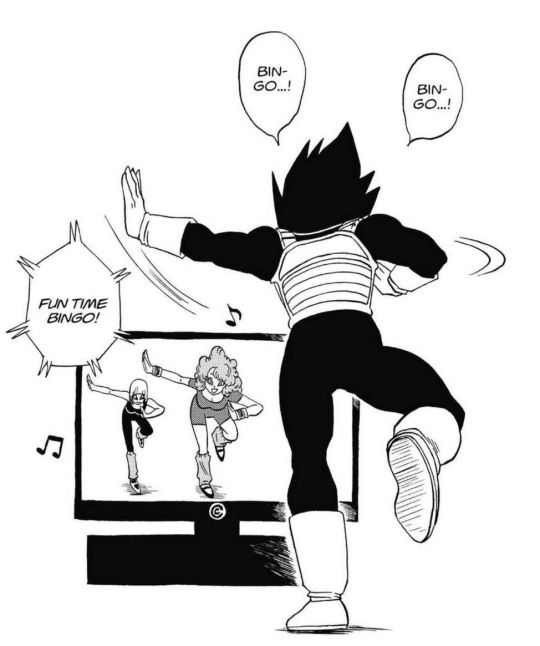
Or, this one of Vegeta learning the Bingo dance he did in the movie, but not in the anime. He also doesn’t do it in this comic, either, as the manga version skips over most of the party. All we get is another panel of Vegeta lamenting that he didn’t get to show off his dance.
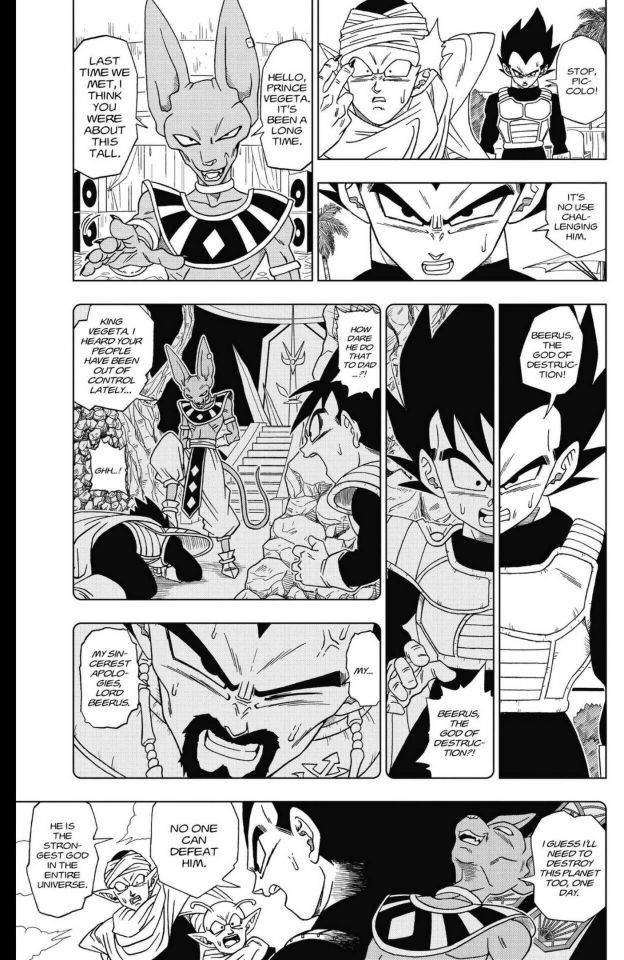
We also get this page where he explains who Beerus is to the others, while also covering the flashback to when he first met Beerus as a child. I really like the way this comic is laid out. I don’t enjoy a rushed re-telling of Battle of Gods, but Toyotaro definitely does a great job with the assignment he’s been given.
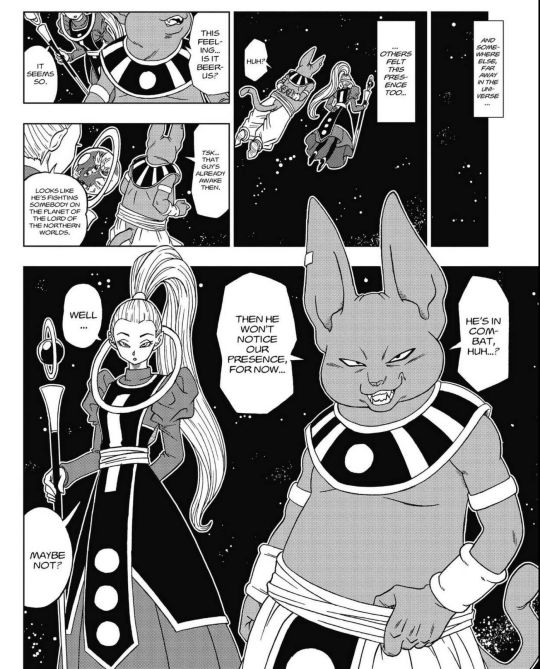
The only new plot element here is the introduction of Champa and Vados, who are destroying planets while Beerus searches for the Super Saiyan God. They don’t want to alert him to their presence, but fortunately he’s too busy to notice them. The only ones who do notice are the Elder Kai and Kibitoshin, who deduce that Champa is looking for the Dragon Balls, but not the ones on Earth. Accordingly, Kibitoshin goes to New Namek to collect their Dragon Balls, thinking this will foil Champa’s plan.
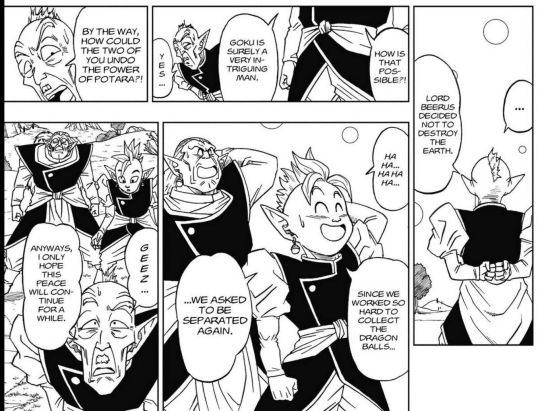
Then it turns out that’s not what it was about at all, so Kibitoshin uses the Namekian Dragon Balls to dissolve his fusion. So now he’s Kibito and Shin again. This would be reflected in the anime, when we see these two in the Universe 6 arc. So I’m guessing this was thrown into show how that happened.
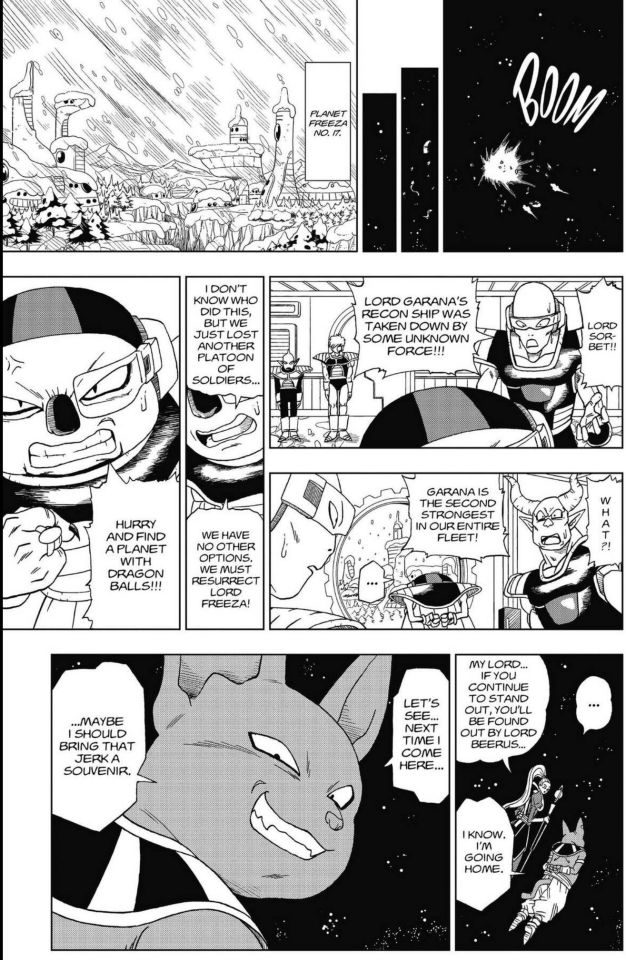
Meanwhile, Champa destroys a Frieza Force ship just as it locates a Dragon Ball. So apparently the Balls Champa are looking for are a third set. According to Garana, the commander of the ship Champa destroyed, these Dragon Balls are enormous. The Frieza Force’s leader, Sorbet, is more concerned with the disappearance of another platoon of his troops. This convinces him that their only hope is to resurrect Frieza.
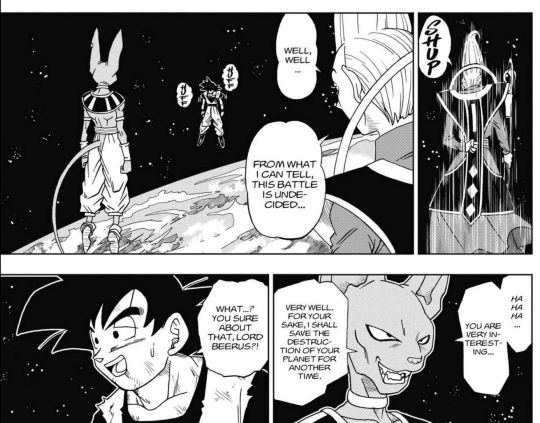
Meanwhile, some sort of Battle of Gods happens. Goku turns into a Super Saiyan God, but he can’t beat Beerus, yadda yadda. In the movie, Beerus blew up a small piece of the Earth to satisfy his word. In the anime, Beerus faked falling asleep so he could spare the Earth without looking like he’d changed his mind. Here, he just decides to spare the Earth, at least for the time being.
So yeah, that’s about it. The art is great, but it’s nothing we haven’t seen before. These four chapters are saddled with recapping a movie while also setting up events in Res F and the Universe 6 arc, neither of which needed a lot of prologue to begin with. I mean, seriously, Resurrection F starts with Sorbet deciding to wish back Frieza. The Universe 6 arc starts with Champa arriving on Beerus’ planet and stating his business. It’s not that complicated.
#dragon ball#dragon ball super: the manga#2023dbapocryphaliveblog#goku#beerus#whis#vados#champa#kibitoshin#supreme kai#kibito#elder kai#vegeta#mr satan#goten#piccolo#dende#king vegeta#sorbet
33 notes
·
View notes
Text
Why did I become an Artist?
I used to draw a lot more. In fact, one of my favorite things to do was draw as a kid, but it faded away (we all know why).
As an adult, I feel it's harder to be creative, but I had that excitement when I was fresh out of high school and I was very much inspired by seeing these game environment artists at the time. I loved seeing their process and how you could make this amazing thing from essentially nothing...from your head! To me that was mind-blowing; coming from a family who had a pretty traditional view on things: go to school, get good grades, get a job, blah blah blah...if you didn't get good grades you were considered a loser.
That's where my art journey began, really.
I eventually learned the video game industry is not exactly great, and moved on to other things. I got inspired by illustrators and animators, but soon realized I was holding myself to too high of a standard, and a lot of the advice was not good for my mental health. along with the rise of AI art I had to take a break from doing drawing for a long time. I moved on to graphic design.
I studied graphic design for 2 years, I loved making things, but it felt impossible to be one. The amount of materials I had to learn was never-ending because jobs always asked new requirements besides knowing adobe CC and programming languages. The whole list of reasons why they wouldn't accept you to the job listed is a can of worms in itself. Then you could be a freelancer.
"but don't you manage your own time as a freelancer? isn't it more easygoing, and all that?" You may ask
Not really. first of all you gotta have a skill that people would pay you for. Secondly, you gotta check how saturated that market is on the platform you want to freelance on. Next, you have to market yourself to death because you will be flooded by other people from overseas working for a lot less money than probably you do. Also if you do creative work like me your "unique" style won't show up on the site's algorithm no matter if there's people who like it or not. it's a very cookie cutter way of creating work. Why did I explain all this? Because I am tired of living cookie-cutter. I wanted to tell stories, I realized that making art is much more than making pretty images. If you want pretty images go to an AI image generator there's thousands of them online. I have learn that art is a form of communication, so I wanted to tell stories with my art. I wanted to write a webcomic. "Wait but doesn't your blog say mangaka? what does that mean?"
Yes I am really inspired by anime. I watch a lot of anime and I love the stories from them. so I want to create stories in a similar fashion. I also really like the anime art style and im really inspired by that and hope to have my own manga one day. However I want to start off with smaller goals for myself and start with learning how to draw and do a web comic first. I told myself I am not going to stress a lot about the art because then nothing will ever come out of my hands. "But most successful webcomics have amazing art, mangas too" I know but you can't just have amazing art from the get go. Also I don't want to pause my whole story just because the art is bad. Take One Punch Man for example, if you look at its early chapters it looked really unrefined. a lot of people sad One's art was terrible, even from himself, but people loved to story and now it's one of the most popular anime watched. A similar story happened with the creator of Attack on Titan
3 notes
·
View notes
Text
A few days ago, on May 25, mangaka Hisashi Eguchi was invited to talk on the radio program TOKYO M.A.A.D SPIN, alongside co-host Kazuhiko Torishima, a former editor at Weekly Shonen Jump. Torishima is most known for being the editor of Akira Toriyama, from Dr. Slump up until the middle of Dragon Ball in 1988.
Eguchi and Torishima discussed the mangaka's most famous work, Stop!! Hibari-kun!, which was serialized in Shonen Jump in the early 80s, around the same time as Dr. Slump. The link above leads to a transcript of a portion of their talk, and I will provide summaries of a few interesting things they discuss:
It's well known that Eguchi created Hibari-kun as a parody of contemporary romcom manga. He notes that he has always went against the "mainstream," such as with his previous work, Susume!! Pirates, being a parody of baseball manga. On the topic of romcom manga, Eguchi has no problem with popular works like Kimio Yanagisawa's Tonda Couple and Mitsuru Adachi's Touch. However, it's because those series influenced a slew of bad copycats that he became jaded on the romcom genre.
Torishima notes that Eguchi's style of creating is one where he usually takes the reins by himself, leaving little room for an editor to chime in, which even the mangaka admits to. Torishima then adds that when Hibari-kun was initially serialized, his first reaction was that of pessimism. The series did not seem to be as "big" as Eguchi's previous Susume!! Pirates, and he notes that Hinomaru Gekijou, the manga Eguchi created inbetween Pirates and Hibari-kun, was a bit poor in quality, so he did not have a lot of confidence in him. Then, Hibari-kun became so popular that it became the "overwhelming favorite" in Shonen Jump. Torishima was shocked, but adds that he also felt a bit of resentment towards Hibari-kun's popularity at the time. The reason why Torishima felt a grudge against Eguchi was that, while Hibari-kun was leading in popularity, Toriyama's Dr. Slump was declining, to the point that he was getting discouraged and wanted to quit the manga. The management at top agreed, given that they had Hibari-kun to carry the magazine. However, in the middle of serialization, Hibari-kun began to go on hiatus, meaning they needed Dr. Slump to stay serialized so that it could fill in the gaps.
On the topic of hiatuses, Eguchi admits that it took him ten days to create a drawing, which meant that he could not keep up with the magazine's weekly release schedule. He proposed to the editorial department that Hibari-kun should be released every two weeks instead, but he was turned down. Because of the series' popularity, an anime adaptation was soon to follow. However, by the time the anime started airing, serialization of the original work had already mostly come to standstill. Eguchi admits that he "raised the bar too high" by focusing on the art rather than the gags. Torishima then adds that he believes Eguchi's nature as a creator is that of one who has a tendency to get absorbed in multiple pursuits, becoming a jack of all trades but master of none, which he believes is a fatal flaw for creators. Both Eguchi and Torishima briefly mention Shigeo Nishimura, the editor-in-chief at Shonen Jump when Hibari-kun was serialized. Eguchi says he does not like the man, with Torishima adding that Nishimura was the editor who made the "cruel decision" to drop Hibari-kun from the magazine in 1983, when Eguchi left the series on a cliffhanger.
So, the main takeaway (🤪) from this interview is that, Hibari-kun almost killed Dr. Slump, and it's because the former went on hiatus that Toriyama was pressed into continuing Dr. Slump, and the popularity of that series carried him into Dragon Ball and beyond.
#stop!! hibari-kun!#stop hibari kun#stop!! hibari kun!#hisashi eguchi#hibari oozora#kazuhiko torishima#manga#shonen jump#weekly shonen jump
3 notes
·
View notes
Text
GUNNM // Canon x OC Ship - Sechs x Ratte

#gunnm - Battle Royale in the Asteroid Belt! ✨ Check out full post on IG for timelapse drawing, wip and close ups! www.instagram.com/p/Cq7ZEHaMvy…
Here’s the first artwork of my Gunnm (Battle Angel Alita) ship released on this profile. I really need to redesign my #ocs old design and see through that I make a proper sheet with a proper reference. Anyways, I’m waiting for the release of the next instalment of the #battleangelalita Mars Chronicle and to satisfy my needs during the wait, I present to you the first picture of what is going to help me to survive the wait!
Ratte is my #owncharacter . She is Zekka’s actual child, although, Zekka ran away to get some smokes and ditch the responsibility when a girl suddenly carried his genes! Ratte wanted to know her father though, so when she found him, he told her that he’d only take care of her, if she would beat him in a fight. Of course, Ratte was but a kid in a cyborg-body. She had no chance against the strongest fist in the universe! However, Zekka was so impressed by the gall this girl had, that he began to teach her martial arts. Fast forward to the Z.O.T is when Ratte had become an adult, a formidable fighter and one of the allies of the Space Angels later on, opposing her own father this way.
More stuff is coming soon! Please stay tuned! 👾
Things to do: Design charactersheet for Ratte. Design satisfactory version of her Fizziroy-Body. Make some slides from the manga. Make a few edits. Make lotsa Gunnm Art! Make more face studies and get into the grid of drawing GUNNM Style. ^^

Ratte belong to me. Sechs is from #yukitokishiro#gunnmlastorder


#battleangelalitalastorder#gr6#sechsxoc#canonxoc#animeart#mangaart#fandomart#artwork#scifiart#sciencefiction#cyberpunk#cyberpunkart#owncharacters#fanfiction#fandesign#alita#alitaoc#fantasyart#futureart#cyborg#android
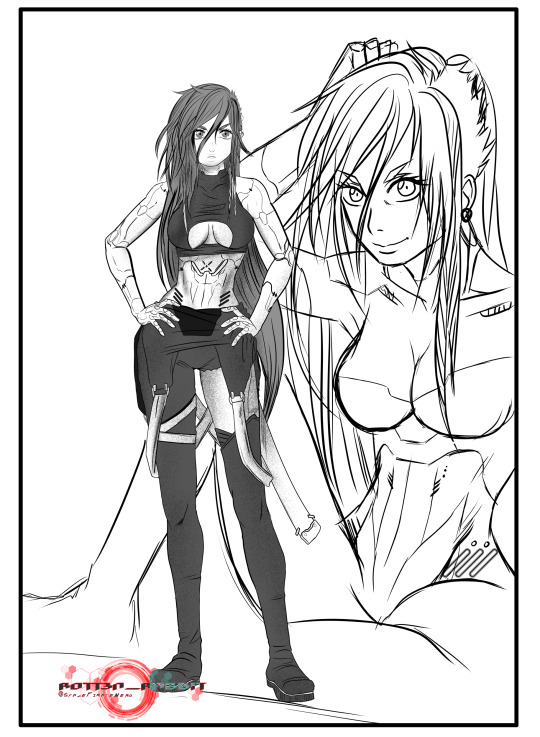
#gunnm - #charactersheet
❤️ Ratte: German for “Rat” // Built 5 years ago, equaling humanoid age of 20 years currently.
👾 Ratte is the dishonourable daughter of the great and famous Zekka, the strongest fist in the universe. She was born a cyborg, an accident that shouldn’t have happened and naturally so, Zekka ditched all responsibilities in this very drunken incident, leaving the "alledged mother/creator" of the child, getting a pack of smokes, never returning again. Ratte’s mother was very ill, taken by a cybernetic virus; she died shortly after the “birth” of the child, hence Ratte “grew up” in the ranks of the Stellar Nursery Society - Guntroll.
💀Only one year after she was built, she changed from a children’s cyborg body to an adult one. The girl never truly had been a child, nor did she ever have the mentality of one. Basically, you could say she was born as an “adult” (mentally). It was Yani, the Cybertech, who eventually built her new body, therefore, Ratte is a secret fizziroy-body-user. Qu Tsang taught her some of her martial arts, however, it was obvious that this fighting style wasn’t for her. Eventually she studied Capoeira, mixing it with influences of Wing-Chun and some secrets of the Panzerkunst, to form her very own, personal fighting style.
🤖Shortly before the Z.O.T Zekka and Ratte met once again and their first meeting wasn’t a pleasant one. Ratte had every reason to be mad at her “so-called father” hence an immediate fight occurred, which Ratte unfortunately lost. However, Zekka had to admit that the girl had some gall and after “somewhat” sorting things out, Zekka taught her some of his techniques as well, being a proper dad for the first time. During the Z.O.T Ratte allied with the Space Angels and the Guntroll team, opposing her father once more, rooting for Sechs to kick his stupid ass!
❤️More info and art coming soon! Pls stay tuned! Love ya’ll! Likes, comments and shares are very much appreciated.

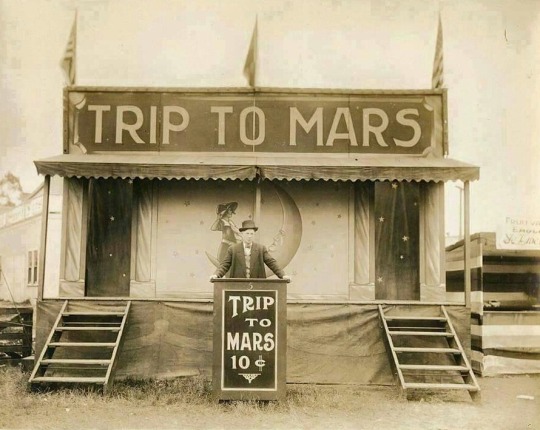
FLASHY LIGHT WARNING
Music Credit - AIM TO HEAD
#gunnm#gunnm last order#battle angel alita#alita#gunnm oc#my oc#my art#spacecore#aliencore#space art#cyborg#scifi art#scifi oc#gif warning#flash warning
15 notes
·
View notes
Text
Oh boy let me tell you, doing this research was not easy and took a whole WHOLE lot of digging just to find.
Finding what Tezuka did and his own personal thoughts on it was like trying to find a small needle in a bunch of big needles in a haystack. I could barely find people talking about it in the first place, it took 5 hours of searching and I fell asleep at my desk out of pure exhaustion. The few sources that I did find on this quest of knowledge were a big mess of multiple different sources from your everyday people, to interviews, articles, people who knew Tezuka personally, etc.. but hardly anything was stated by Tezuka himself and that was a major problem that I faced.
People can form assumptions on somebody, and what they were thinking and what they could've been thinking and who they could be as a person in this situation based on the images they saw displayed, but in a situation like this none of it can be considered straight factual as it's only an assumption based on a few images and not straight from the source or being looked at with a full whole. And for this situation you can't just pass it off as "Well everyone was racist back then, it's to be expected" as it's made clear Tezuka wasn't racist, hated all forms of conflicted in general, and especially hated racism. So this just left me with a huge question mark.
So I gathered information about things stated by Tezuka himself, with these things being even harder to find. Let's start with this one.
"One day, completely in my own style, I was playing Mozart’s Turkish March. All of a sudden a Black soldier entered the room. There was nothing really strange about an American soldier being at the YMCA. He took a sheet of music from the piano, and once I was finished playing began to sing in tenor.
It was something that I had heard before. It was a march. Eventually I realized that it was the aria “This Butterfly Shall Fly No More” from The Marriage of Figaro. To a Mozart piece, he had responded with a Mozart aria. He was a great opera fan, this intellectual Black soldier named Joe. . .
One day, after learning that I liked cartoons when I drew a quick caricature portrait of him, he brought me a mountain of American comic books. It was like the heavens opened and rained manna. There were absolutely no manga materials around at the time. I read through them like a worm, was overjoyed, and copied them obsessively. . .
My friendship with him might have been short, but it became the reason I decided to become a manga artist."
So his friendship with a black soldier named Joe and him drawing said soldier and that soldier giving him comics is what kick started his whole career as a mangaka, and he treasured his friendship with him. So that makes it clear that Tezuka had no hate in his heart against black people, only seeing them as people and he even saw him as a good friend, and crediting his interaction with him as the start of his mangaka career.
But as heartwarming as it is, that just confused me even more. He clearly had no hate towards black people, and his mangas make it even clearer that he absolutely hated racism and everything it stood for. So what gives? Why do his mangas have racist caricature and characterization of black people when he wasn't racist?
I believe it involves two words. The west.
Why do I say this? Tezuka took inspiration from Disney, he loved American comics stated by himself. And back then, even though he was made aware of the racism in America, Japan was still sheltered and he wasn't made aware of all of it, even if he tried to grasp the whole narrative it was hard given the time it was all set in.
In an article I read, it was stated that-
"He was accused of racism after drawing blacks in stereotypical fashion, but insisted that he was only continuing the styles he saw in American comics and films. This point has often been a source of constant soul-searching among Tezuka's publishers, especially in the USA. As of 2003, Dark Horse has begun to publish Tezuka's manga wholly unedited in the US, adding a disclaimer that states that while Tezuka held no racism himself, his artwork was a product of its time, and that further that it would be wrong to retroactively change his works without his input."
Now we can all agree that the way Dark Horse handled the situation caused mixed opinions amongst people, but we are here to focus on TEZUKA himself, not the company and their thoughts on it. Tezuka said that he only drew them the way he did because he was continuing the styles that he saw in the west. It's clear Tezuka wasn't trying to be racist, but unfortunately misrepresented black people because Tezuka wasn't aware of the whole picture and didn't realize that the way black people were portrayed in media was made on the same hate towards black people outside of the media in the real world.
This realization probably further soured his opinions on America's racist actions and beliefs and it seemed to have been driven home as shown by this article quote-
"Reactions over his images of black people did not fare much better. Tezuka remembered well how in the mid-1960s requests had come from U.S. black civil rights groups for the artist to present his black characters more realistically. In 1965 Tezuka reportedly met white executives from the U.S. television network NBC, who attempted to persuade Tezuka to present his black characters in a way more acceptable to the American public."
Now this was 1965, the same year when the civil rights act was created, and this was none other than NBC itself. Tezuka was caught in a rift between two sides that he is only now being really made aware of. Now I remember hearing about Tezuka meeting with black people so I'm assuming this was when he was getting his information and feedback from them that you asked about. But the meeting up part is only what I heard so take it with a grain of salt, I know I saw it in an article but that article ceased back into the haystack and despite my search I couldn't relocate it, so again take it with a grain of salt.
"Tezuka later recounted these incidents in interviews and even skeptically satirized his meeting with TV execs in his 1974 comic Kami no Toride (Paper Fortress). Tezuka eventually agreed to their conditions, but unlike the UCLA incident, he indicated retrospectively that he had misgivings about those racially oriented requests."
So in conclusion, yeah, Tezuka wasn't racist, he hated racism, he hated America being racially motivated and didn't like racist people trying to drag him into their bad intentions and him unfortunately being influenced by America's view of black people in media without even realizing it. And it's clear that he got better and better with drawing black people in manga as time went on. He made a genuine mistake, but that mistake doesn't make him any less of a good person who just wanted peace and everyone to get along. And that's what makes his story so incredible to read, especially with the time it was presented in. And this isn't the first time for him either as I recall it being mentioned that Tezuka had an interaction with a girl about one of his stories and after hearing her opinions on it decided to go about his female characters with more sensitivity. Tezuka was a good guy who, even as the god of Manga, had his own bumps along the way like the rest of us, but each time he made himself aware and bettered himself as a person. I think that makes him more of an incredible mangaka rather than just his title as the god of Manga.
My repost before this one is basically a TLDR of all this research that I did and I hope it helped clarify things a bit. I'm sure this isn't perfect, but it helped me to understand things a bit more and I hope it was able to help you as well ^^
I think this is a manga panel that captures Osamu Tezuka as a complicated mangaka who didn't always get race right.
In Vol 7, Astro Boy is recruited by a Japanese American immigrant to help an American robot register for the right to vote. The man gives Astro Boy a lecture on the racist atmosphere, how the whites mistreated Japanese immigrants.
But not only that, but he says "By the latter half of the twentieth century, white started treating us better, but they still acted horribly to Black people."
And said Black person in the panel is a racist caricature.
And you'll see those also in other Tezuka's work like Black Jack, which tackles anti-Black racism in both America and Japan, even decently drawn Black persons co-existing alongside Black caricatures.
So here is Tezuka in the 60s attempting to make a nuanced observation about American racism (that still speaks to us today) but still perpetuating an anti-Black caricature profile.
CW: Racist depiction below

#osamu tezuka#tezuka productions#astro boy#mighty atom#tetsuwan atom#manga series#manga panel#manga art#manga#mangaka
44 notes
·
View notes
Text
Prime Directive #0 - let's get the ball rolling
Here we go. It's happening, just as I threatened. Let's start our look at Dreamwave's first Transformers G1 miniseries, Prime Directive, one issue at a time. Pray for me, folks, people keep reacting in horror to me telling them about this project and it's making me nervous.
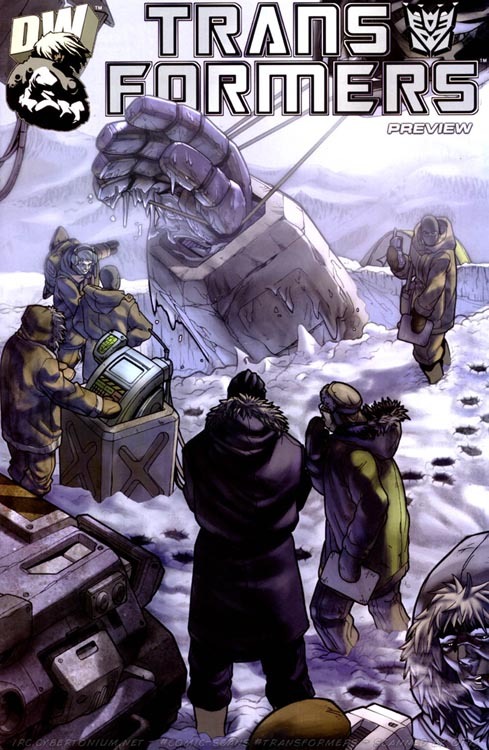
Some context before we begin our comic today, though. When it came out in 2002, this miniseries was the first attempt to seriously reimagine the G1 franchise since it originally ended in the West. The then-contemporary mainline Transformers fiction was anime prouced either wholly by or in conjunction with Takara, and none of it was in the style of the original G1 cartoon. In 2001, the Takara-made Car Robots series was imported by Hasbro, dubbed, and tweaked a little into the Robots in Disguise cartoon. In 2002, when this comic came out, Takara and Hasbro's joint efforts had resulted in the Armada series. Both were complete reimaginings of Transformers compared to what had come before.
So unlike today, when G1 nostalgia is ubiquitous enough that a common complaint amongst the fanbase is that it's impossible to escape, when Dreamwave released this comic there hadn't been any G1-esque English language media of note in years. In addition, the early 2000s were the start of the nostalgia boom we're still living through today in terms of pop culture, where the process of old franchises being strip-mined for constant reboots began. 'That cartoon you liked as a kid is getting a new comic, and it's for ADULTS this time!' was still a selling point with some novelty to it. The stage was very much set for this to be a succesful endeavour, and Dreamwave was banking on that to be their big break as a comics publisher.
And with that, here we are, folks: the first issue of Dreamwave's big Transformers revival. ...Sort of?

Before Dreamwave published their first Transformers miniseries, Prime Directive, a 6-page preview was produced to be sent to retailers. If you've followed any monthly comics before, you'll probably know that ahead of an issue dropping, companies typically release 4-6 pages as a preview ahead of time; this, by contrast, is an entirely original piece, taking no content from the upcoming first issue. If nothing else, that gives a good indication as to how hard Dreamwave were banking on the Transformers license being their big break.
The thing this preview is most remembered for is probably that it features five pages of nothing but humans talking, with only one brief glimpse of any robots. We open on said humans in the arctic, a setting which is notable because a) it gives me immediate Bayverse vibes and b) it's very obviously been picked so Lee doesn't have to draw too many backgrounds. I mean, look at this.
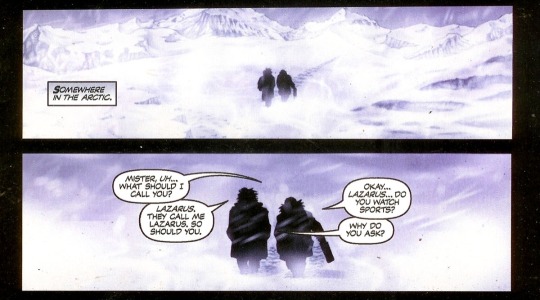
And hey, let's be fair. It's a lot of extra work to draw six whole pages just for a preview. There'll be plenty of other reasons to call Lee a lazy hack as we go through this project, so I'll let him off easy here.
What I won't be as kind to is the dialogue.
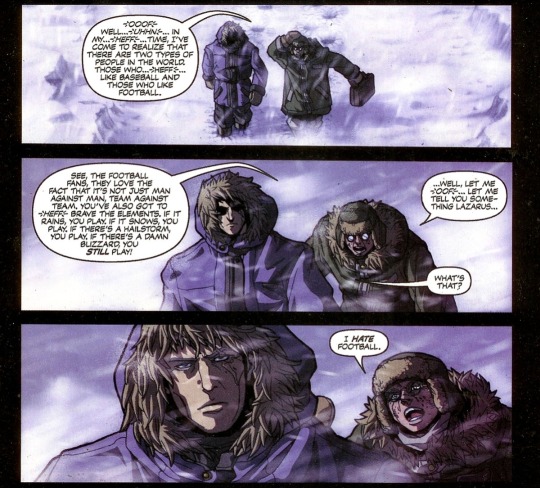
Right off the bat we begin with a very clumsy attempt to get some themes in here. When you're working within such a small pagecount, that's a wee bit tricky. A deft writer might have a conversation pull double duty, telling you a couple of each characters' quirks so they immediately feel like more than cardboard cutouts while having it relate to a wider idea. Since Sarracini is not a deft writer, instead we get a sports metaphor that makes no sense whatsoever and which goes on for two whole pages.

Decompressed storytelling was a big thing in comics around this time, with western monthly releases experimenting a lot with the sort of slow moving, character-focused pacing found in other examples of the medium, like longer form graphic novels and manga. Unfortunately, a lot of the people who jumped on this wound up not understanding how to make it work on a structural level, and they really just made less things happen per panel and page to imitate the aesthetic elements. Dreamwave is an absolutely stupendous example of this approach. This is all foreshadowing.
What we actually learn in these two pages is that this Lazarus guy has taken the other guy to the arctic. He's some kind of potential investor in a project Lazarus is looking for partners on. Lazarus apparently hasn't explained why exactly wandering around the frozen tundra is important, and the other guy is understandably pissed. It's a little unclear why he came along to the arctic when he has no idea what Lazarus wants to invest in, but here they are, trudging through the snow.
So they argue, and then a very confusing set of panels happens.
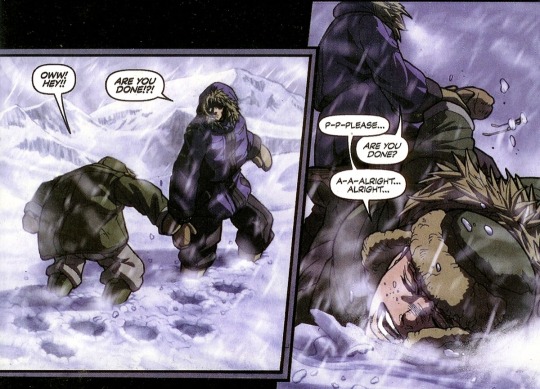
I had to squint at this for a hot second to work out Lazarus is supposed to be grabbing him painfully. Lee is not a master of… much of anything, art wise. And clear, readable action is something he struggles with from the get go. Anything that needs a reader to understand implied motion and momentum has a good chance at winding up a dud.
No worries though. We get straight back to po-faced declarations of The Themes Of The Comic, Honest, which only requires that he draw people standing around.
I have a high tolerance for comic book-y expository nonense. But it's so entirely joyless here. Shoot me, I have to read the entire rest of this fucking series.
On the next page, we finally get to something Transformers related I can draw your attention to, though. There's a full page of them coming across a monitoring set up for something (oh my, I wonder what it could be) in the ice. It's more space filler of no real interest, but this particular text box might ring some klaxons in a modern day Transformers fan's head:
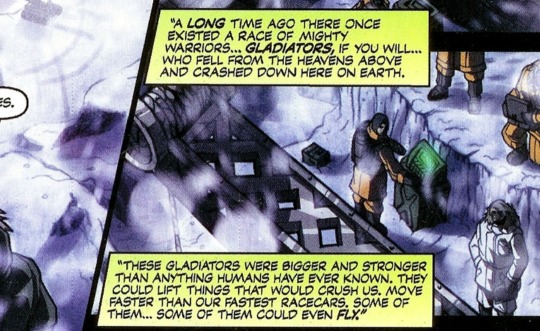
Now, this isn't an example of 'what do you MEAN, Dreamwave did that first?!', a refrain that will crop up quite a few times as we make our way through these comics. It's true that a shocking number of franchise staple concepts originate in Dreamwave, but the gladiatorial element isn't one of them. That goes back to Marvel, with the UK-only prose story "State Games" establishing it as part of the backstory for both Megatron and Optimus. But it is notable that Dreamwave is going to be where a lot of people encounter this concept for the first time, given that the prior story was not just a UK exclusive, but specifically a prose story tucked away in an annual rather than the regular monthly comic. (And yes, spoiler alert: it will crop up again in Dreamwave.) I would not be surprised to find out the revival of this concept in places like the Aligned continuity owe at least some debt to the idea resurfacing in this series.
Anyway, the comic then tries to persuade us that the thing most of interest when it comes to what can be gleaned from terrifying alien war machines with all the onboard tech and weaponry they have is that they turn into cars sometimes. No further explanation is forthcoming. Lazarus just sort of says this as though it's self evident and moves on.

Look, making the fact Transformers characters can transform central to the fiction is my whole thing. I want it. When Transformers media doesn't take advantage of that stuff, I am sad. But the degree to which this falls flat is a bit of a warning as to a problem this series is probably going to come up against a lot as we go on, and which plenty of recent Transformers media aimed at fans has struggled with. How do you do things like that in something that isn't made for eight year olds and running on "rule of cool"? Transformers turn into cars and planes and weird animals and such because that's cool to a child who wants to buy awesome toys. It's tricky to translate that into a story aimed at adults that takes itself remotely seriously. In no way impossible. But if you don't really consider how you plan to approach that part, and indeed a great many elements integral to Transformers, you're probably not going to nail it.
They talk for another goddamn page after this and oh my god, this preview should have been three pages tops. I'm not making you read all that. Just rearrange the words in one of the above panels, it's about the same experience.
Finally, FINALLY, we hit the jackpot with the last page: a full page spread of Soundwave, partially obscured in ice as they excavate him. (See? Bayverse vibes.)
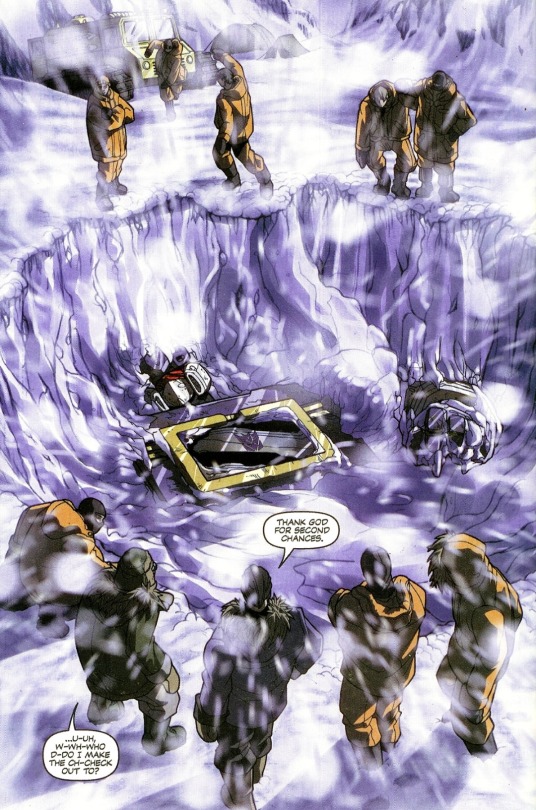
Soundwave is pretty much the single most iconic non-Optimus Transformer in broader pop culture, so that tracks. (Honestly, he'd probably give OP a run for his money.)
And it is a very nice bit of imagery, though they really didn't need those damn speech bubbles down there. But you can see here where the concept for this preview originates. All the build up being so you can have the final full-page splash of an 80's-style iconic character to get the audience hyped up. In the hands of a better writer, that would probably have worked perfectly well. As it stands, the fact this apparently did get people hyped is really more just down to Soundwave being really cool, I reckon.
So that's the preview. It's on Earth, the robots came to Earth a long time before under circumstances we don't know about, and now some shady humans have found one of them. It's a decent enough setup. One so good it's been used in Transformers at least twice; seriously, that is just a description of Megatron in Bayverse, right?
After all this riveting comic content, the original version of the preview also featured some teaser art. This gives us a bit more of an idea what the upcoming series might look like, since we get all of one panel of Lee actually drawing a robot in this one.

Pat Lee's art is, of course, one of the more infamous elements of Dreamwave's comic. He called his style "anime inspired" a lot, which was a real exciting prospect in 2002 if you were a certain kind of nerd. You can sort of see some of it in his art. In that very 'western artist in 2002 working off an English language how to draw manga book' way that is a peculiarity of the time period. But it sure doesn't look like, say, the Transformers work of Studio OX.
More to the point, his artwork is frequently a mess, with terrible composition, incoherent proportions, very little understanding of perspective, and little to no emotion conveyed by its characters. He tends to draw his robots all very... puffy and inflated-looking, too. This style would form the basis of a 'house style' all other artists brought in were expected to follow. Even when much more competent artists than Lee are to be seen, they'll be somewhat shackled by the restrictions put in place there.
And that's a wrap on this wee little six page preview, so god knows how much I'll have to say about the series itself. Stay tuned to see if any robots get to speak next time!
65 notes
·
View notes
Text
Now We Know About the Facts Of Lougosi And How Most Fans Find It As Endgame
Trivia
Legosi and Louis are both canonically physically attracted to each other. They are the reason they realize their carnivore/herbivore fetish. In Chapter 91, Louis realizes his carnivore fetish in the car with Ibuki, but states that he thinks it all began with Legoshi. His words are "Because their bodies are strong, they have a profound sense of camaraderie. Because they hunger for meat, they always look like they're suffering somehow...why did it take me so long to realize this? I like carnivores. I think I have for a long time now, all because of that idiotic underclassman (Legosi)." In Chapter 114, Legosi realizes his herbivore fetish when admiring Louis.His words are "I look at his face and get the usual thought. Why are herbivores such beautiful life forms?"
It's revealed in one of the extras in the manga (Unpacking Legoshi's Belongings) that Legosi started carrying a nail file in his backpack after Louis drew attention to his hands [2].
In an omake surrounding Chapter 76, Itagaki makes a joke about Louis and Legoshi kissing/being intimate.The omake shows two girls talking to each other. One says, "I saw two guys hugging on the balcony today" (referring to Louis and Legoshi hugging on the balcony in Chapter 76). The other goes, "did you close the curtain for them?"
In the last panel of Chapter 77, the narration for Louis and Legosi's hug state that "even with their environments changed, they never lost their trust in each other. Only the moon sees them now.""The moon is beautiful" (tsuki ga kirei desu ne) is a euphemism for "I love you" in Japan.
Louis states that his leg hurts whenever something bad happens to Legosi.This was true for when Legosi got hurt fighting the drug cartel, and for when Legosi was shot by Melon. This is the only indication of anything supernatural in Beastars,
Louis can be seen blushing and fanning himself in one panel of Chapter 88, in the scene where Legosi is cross-dressed in heels and makeup.
In multiple panels of Chapter 96, the composition of the scenes compares Legosi's relationship with Louis to Riz's relationship with Tem. This is likely due to the fact that Legosi and Louis represents a good carnivore-herbivore relationship, unlike Riz and Tem. However, it is an interesting comparison because Riz's feelings toward Tem were heavily hinted to be romantic.Riz says in the scene, "it's the only thing...my feelings for him (Tem) are much stronger than your feelings for Louis-Senpai. Because he (Tem) never felt the same for me."
In Chapter 143, Louis can be seen blushing when he is with Legosi and the Shishigumi.Louis does not blush during his kiss with Juno and during his date with her in Chapter 194.
Legosi is the only character in the series (only Oguma, Kyuu, and San, who were part of Louis' past, as well as Bill who found out on his own and Ibuki) who knows about Louis being sold as meat in the black market in childhood.
Louis is the only character in the series who knows about Legosi's dreams of becoming an insectarium keeper (according to Legosi, Chapter 158).
Louis is the only character other than Jack and Yahya who knows Legoshi's grandfather.
Legosi is the only character in the series who has made Louis laugh on-screen, and is also the first and only character to see him cry. This occurs in Chapter 88, when Louis laughs at Legosi's cross dressing. The latter occurs in Chapter 95, when Legoshi is about to battle Riz.This excludes Louis' hysterical laughter when asking the Shishigumi to eat him, as it was laughter caused by insanity, not amusement.
The style in which Itagaki draws panels draws certain scenes between Legosi and Louis (light grey airbrush with flecks and hazy overlays) is the same style she uses for scenes between Riz and Tem and scenes between Legoshi and Haru.
The music that plays for Legoshi and Louis' play scene is the same that plays in scenes between Legoshi and Haru.The music is/is a rendition of "Beastars classical OST" by Satoru Kosaki.
Louis and Legoshi has appeared alongside each other in more promotional artwork than any two characters (Legoshi and Haru included).
Both Louis' and Legosi's sexuality is hard to categorize: Louis states he has grown to be exclusively attracted to carnivores (first mentioned in Chapter 91, confirmed in Chapter 143 as he vomits trying to have sex with a female red deer). When Oguma asks Louis whether he likes women in chapter 157, Louis does not answer. Similarly, Legosi is exclusively attracted to herbivores - mentioned and confirmed in chapter 114. Legosi also admits Pina (a male herbivore) to be attractive in chapter 66. Both are confirmed to have a carnivore/herbivore fetish.
While the author's original idea was to make Legoharu an endgame, there are many hints for a quite possible, future romantic relationship between Legosi and Louis after all - or at least for Lougosi being a semi-canon ship in a spin-off. It for sure has a big potential for eventually becoming more than just a fanon pairing. A lot of the Beastars fans are also questioning Louis's sexuality - especially after the chapter 157 in manga - and think he might be gay or bisexual. One thing's for sure - Paru Itagaki is teasing Legosi and Louis's relationship quite a lot and it's hard to say, if it's only ship teasing for the Lougosi shippers content, queerbaiting, or is she considering them really being together at some point. Additionally, we from interviews that Paru Itagaki does not outline all scenes beforehand (such as the LegoHaru scene in the love hotel), creating more potential for Lougosi in the future.
I knew there had to be a reason why so many fell for this ship early on, there are key facts explaining it
239 notes
·
View notes
Photo
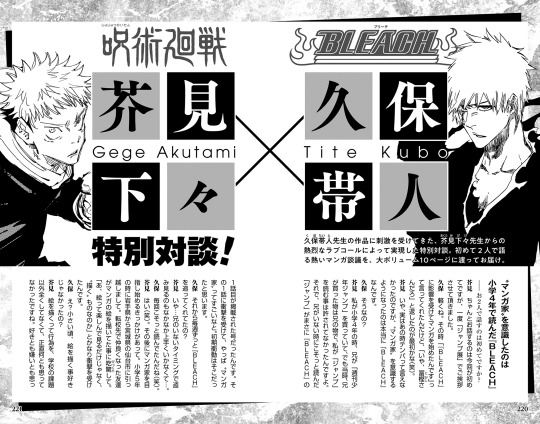
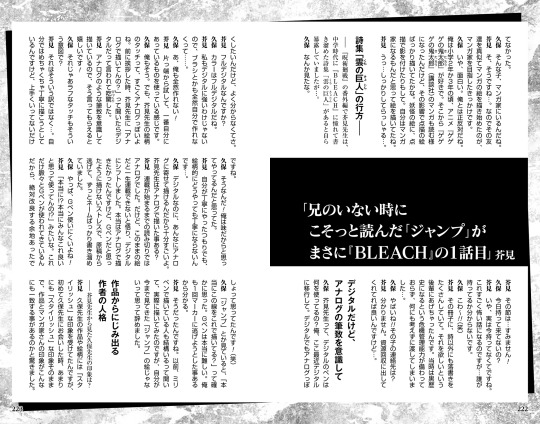
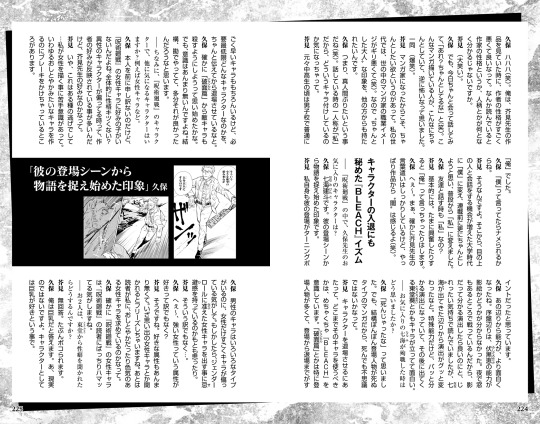
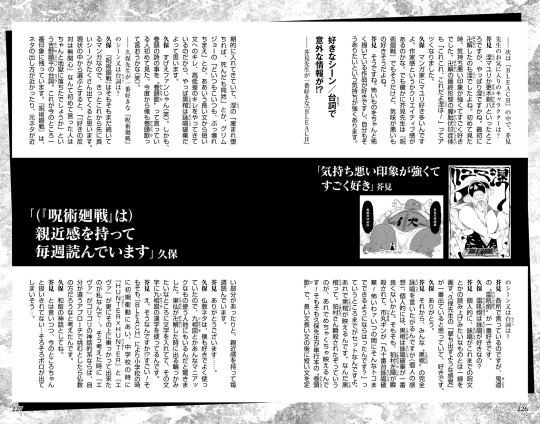
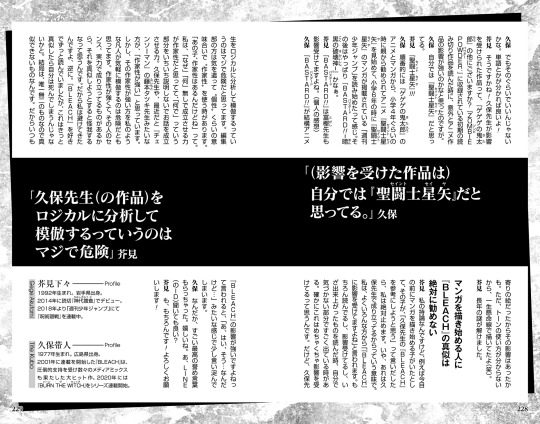
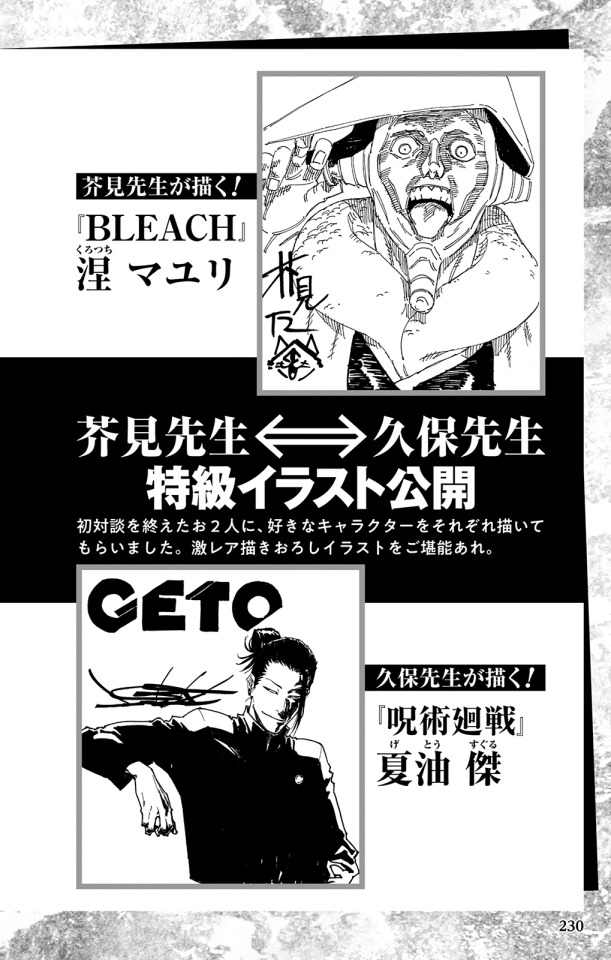
Gege Akutami x Tite Kubo special talk that was featured in Jujutsu Kaisen Official Fan Book.
This exclusive interview was arranged at the ardent request of Gege Akutami, who was motivated by Tite Kubo’s works. We are pleased to present this hefty 10-page transcript of their first long, heated discussion about manga.
Gege Akutami
Born in 1992 in Iwate Prefecture. Debuted in 2014 with the one-shot Kamishiro Sosa. His current series Jujutsu Kaisen has been serialized in Weekly Shonen Jump since 2018.
Tite Kubo
Born in 1977 in Hiroshima Prefecture. His previous series Bleach, which started in 2001, was a massive hit that received universal acclaim and numerous multimedia adaptations. His current series Burn the Witch began serialization in 2020.
Learning About “Mangaka” by Reading Bleach in Fourth Grade
Is this your first time talking to each other?
Akutami: This is our first proper conversation, though we did greet each other once at a Jump Exhibition.
Kubo: Briefly. Back then you told me, “I started a new manga that’s inspired by Bleach,” and I replied, “Don’t you mean ‘by Togashi-san’?” [laughs] (TN: Yoshihiro Togashi is the creator of YuYu Hakusho and Hunter x Hunter.)
Akutami: I was too wound up at the time to say this, but Bleach was actually what introduced me to the concept of “mangaka” (manga artists).
Kubo: Oh really?
Akutami: When I was in fourth grade, my older brother would always buy Weekly Shonen Jump. However, he never let me read the issues he bought since he was very possessive of his belongings. One day when he wasn’t around, I secretly opened an issue and it happened to be the one Bleach debuted in. That first chapter was so impressive, it made me realize just how incredible mangaka are. I’ve been hooked ever since.
Kubo: Did you start following Bleach on a weekly basis after that?
Akutami: Nope… I could only manage to sneak a peek whenever my brother was gone…
Kubo: You had to read in secret every time? [laughs]
Akutami: Yup. [laughs] And soon enough, something happened that pushed me to become a mangaka myself. When I was in fifth grade, we moved from Iwate Prefecture to Sendai in Miyagi Prefecture. I was surprised to find out that one of the friends I made at my new school drew manga-style art. I was blown away, like, “Are you telling me art isn’t just fun to look at, it’s fun to draw too?”
Kubo: Wait, did you not love drawing as a kid?
Akutami: I didn’t draw anything outside of school assignments, and frankly, I couldn’t care less about it. I neither loved it nor hated it.
Kubo: Yet you grew up to be a mangaka, huh.
Akutami: I-I guess… Anyway, I started to mimic my friend by drawing my own manga, and that’s how my dream of being a professional mangaka was born.
Kubo: Amusingly, I was the exact opposite. When I was in second or third grade, I loved the GeGeGe no Kitaro anime. Then I became an avid reader of the GeGeGe no Kitaro manga, which influenced me to draw nothing but pointillist art—I even added dotted shadows to yokai sketches. The whole reason I got into drawing was to become a mangaka.
Akutami: Whoa… Sounds like you had it all figured out…
The Whereabouts of Kumo no Kyojin
In a bonus chapter of Jujutsu Kaisen, Akutami-sensei made a bombshell reveal—he wrote and compiled a Bleach-inspired poem anthology called Kumo no Kyojin (The Cloud Giant) in middle school.
Kubo: This I gotta see.
Akutami: I was young… I’m sorry!
Kubo: Did you bring it with you today?
Akutami: Well, the truth is I don’t have it anymore. And the scariest part is… I have no idea who does.
Kubo: Nooo!! [laughs]
Akutami: Poems aside, there were also a bunch of sketches in that notebook. I ended up giving it to one of my juniors who wanted it. Back then, I didn’t have the crisis management skills to recognize it could be used as blackmail, so I handed it over without a second thought…
Kubo: That sucks!! Do you have their contact info?
Akutami: I do not. I hope they threw it out for recycling…
Digital with an Intentionally Analog Touch
Kubo: Akutami-sensei, what kind of digital pens do you use? I recently made the switch to digital. My goal is to make digital art with an analog flair, but I’m not sure how to achieve that.
Akutami: Did you go full digital?
Kubo: At least for coloring.
Akutami: I’m no expert at digital art either. I can’t even create my own custom brushes…
Kubo: Uh, neither can I!
Akutami: I just give every feature a whirl, and stick with whatever’s most convenient for me.
Kubo: Same here. Though I have to say, your designs have a very analog texture to them. I asked if you’re a traditional artist during our introductions earlier, and was shocked to learn that you draw digitally.
Akutami: I intentionally draw with an analog touch, so I’m happy to hear that from you!
Kubo: In that case, do you deliberately roughen up your art too?
Akutami: That part’s not deliberate… I draw as carefully as I can, but I guess it just doesn’t come out right.
Kubo: Got it! I thought you were purposely going for that style.
Akutami: No matter how much effort I put in, it doesn’t seem to come across in my designs…
Kubo: It’s still amazing how analog your art looks despite being digital. Have you ever drawn manga the old fashioned way?
Akutami: All the one-shots prior to my first serialization were drawn traditionally. However, I switched to digital once I realized I’d never qualify for a weekly series unless my art improved. I genuinely wanted to keep drawing on paper, but I was so stressed out from not being able to control a G-pen that I abandoned my existing manuscripts and worked only on new storyboards for a while.
Kubo: Yeah, G-pens are a pain to use!
Akutami: I was like, “Seriously?! Do people seriously enjoy using this thing?!” Since it was taking me forever to master the G-pen, I figured I definitely had room for improvement! [laughs]
Kubo: Some of the art I see in Jump makes me go, “Were these lines really drawn with a G-pen?” They’re extremely tricky. I once ditched them in favor of markers, so I would know.
Akutami: My thoughts exactly. In the past, I also heard that a decent amount of people draw with fineliner pens. But when I tried them for myself, I drew the most un-Jump-worthy art I had ever seen, so I gave up.
Series Oozing with the Creator’s Personality
Akutami-sensei, what’s your impression of Kubo-sensei?
Akutami: His series and designs always struck me as stylish—and when I met him for the first time, I got the impression that he himself was equally stylish. I was astonished that a mangaka could have so much in common with their series.
Kubo: Hahaha. [laughs] From looking at your series, I assumed you’d have an evil personality. I mean, don’t you get a sense of an author’s disposition or temperament by reading their work?
Akutami: [cackles]
Kubo: But our interactions today made me go, “Huh? He’s behaving nicely.” [laughs] It’s almost terrifying to see the person behind a manga such as that acting in a manner such as this.
Everyone: [bursts into laughter]
Akutami: It’s precisely because I’m a mangaka that I try to behave myself. You see, my generation has a rather negative perception of a mangaka’s occupation. [laughs] So I want others to view me as a respectable adult.
Kubo: In other words, you want to set a good example. [laughs] I notice you’ve been using “watashi” (gender neutral, formal) as your first-person pronoun this entire time—what sort of image are you trying to project?
Akutami: Back when I attended an all-boys middle school and high school, I tended to use “ore” (masculine, casual). (TN: “Ore” is Kubo’s pronoun of choice.)
Kubo: ‘Cause you’d get teased if you used “boku” (masculine, formal)?
Akutami: Exactly. Later on, when I got more opportunities to speak with superiors in college, I switched to “boku.” Then before my series went weekly, I decided to act more respectably and defaulted to “watashi.”
Kubo: Do you use “watashi” even when chatting among friends?
Akutami: Basically. Sometimes I let an “ore” slip if I’m in a good mood.
Kubo: Fascinating… Although you’re certainly careful with your words, I still feel a darkness emanating from your series. [laughs]
The Ins and Outs of Characters: Hidden Lessons From Bleach
Kubo-sensei, who’s your favorite character in Jujutsu Kaisen?
Kubo: Kento Nanami. I began to grasp the meaning of the story once he was introduced.
Akutami: I also consider his introduction to be a turning point in the series.
Kubo: The powers got more interesting around then. Early on, I wasn’t sure if Megumi Fushiguro’s technique had anything to do with shadow puppetry. I was growing impatient while reading ’cause even though he was fighting at night in a place with windows, he didn’t utilize shadows the way I expected him to. But after Nanami came along, the direction took a sharp turn; even the strangest techniques became easy to understand, and more standout characters like Aoi Todo joined the fray.
How did you feel when your dear Nanami was killed in action?
Kubo: I was like, “Aw man, he died.” But I wasn’t shocked, since this is the type of manga that doesn’t shy away from killing off characters.
Akutami: Bleach taught me a lot about when to retire characters and how to make use of them until their time is up. The Arrancar arc in particular involved a huge cast, and even though some characters obviously weren’t around for long, you got to learn the bare essentials of who they were before they left.
Kubo: It’s true that I started to actively kill more villains during the Arrancar arc. However, those weren’t calculated decisions. I mostly relied on my gut, which I suppose was for the better.
By the way, have any other Jujutsu Kaisen characters piqued your interest? Among the girls, for instance.
Kubo: I hate to say this in front of the man himself, but none of the female characters in Jujutsu Kaisen are my type. They’re all pretty formidable, aren’t they? When characters of the opposite sex get preferential treatment, they usually reflect the creator’s tastes, so that must be Akutami-sensei’s type.
Akutami: No, that’s just me taking the easy way out… I’m aware I suck at drawing women. In fact, I often put on the brakes before I create so-called “ladylike” characters.
Kubo: While your male characters come in all types, I feel like your women largely fit the same mold. Could it be that you have an aversion to creating female characters who conform to gender roles?
Akutami: That’s not quite the case…
Kubo: For real? And you don’t have a preference for the “strong female” archetype?
Akutami: Well, it’s not as if I prefer any archetypes in particular. If you were to ask me about my favorite female characters, I’d freeze up. Besides, I don’t know if the readers even want to see any ladylike or seductive female characters from me.
Kubo: I’m sure Jujutsu Kaisen readers are perfectly content with the current roster of women in the series.
How would you two respond if Todo asked what type of girls you like?
Akutami: I wouldn’t. He’d probably beat me up.
Kubo: I’d answer, “Busty ones.” Ah, that’s not my type in real life though. I only prefer big boobs on fictional characters.
Next question is for Akutami-sensei. Who’s your favorite character in Bleach?
Akutami: Either Mayuri Kurotsuchi or Kenpachi Zaraki—if I had to pick one, Kurotsuchi. He was the earliest to perform Bankai, after all. I loved how utterly disgusted I felt when I saw him for the first time. His Bankai’s final form, Matai Fukuin Shotai (Demonic Recumbent Womb), made me scream “Yes, yes, that’s my man Kurotsuchi!” in excitement.
Kubo: Mayuri’s pretty popular among mangaka. Perhaps they relate to his inventiveness and creativity. Speaking of which—Akutami-sensei, I can tell from Jujutsu Kaisen that you must be a fan of the grotesque as well.
Akutami: You’re right. I enjoy series that depict scary things in a genuinely scary way, and I strive to practice what I preach.
Surprises Regarding Favorite Scenes and Quotes
Akutami-sensei, what’s your all-time favorite scene or quote from Bleach?
Akutami: I’ve mentioned this elsewhere, but I love the Kido spell “Raikoho” (Fiery Lightning Howl).
Kubo: Due to its incantation?
Akutami: In my opinion, what sets your incantations apart from the other magic chants I’ve heard over the years is that yours evoke the strongest sense of impact. That’s what I love about them.
Kubo: Thanks.
Akutami: On that note, even though everyone seems eager to do the full incantation for Kuro Hitsugi (Black Coffin), I personally prefer the incantation-less version. First of all, Sajin Komamura getting wrecked and Gin Ichimaru saying “A level 90 unspoken Hado! Now that’s scary! When did you achieve that?” are such an iconic duo. They really made Kuro Hitsugi shine. How, you ask? By highlighting that it annihilated Captain Komamura in an instant, for goodness’ sake! To put things into perspective, Kubo-sensei routinely fills the “opening songs” of his volume releases with walls and walls of text, followed by a brief verse like Kurotsuchi’s “Born and then fall is the same as death” or Grimmjow’s “Break down, every single one of you.” The transition from long sentences to short phrases creates a sharp dichotomy that brings to mind a Kuro Hitsugi with no incantation. (TN: Those verses are from Volumes 35 and 24 of Bleach, which feature Mayuri and Grimmjow on the cover, respectively.)
Kubo: Wow, you’re a hardcore fan. [laughs] Nobody’s ever referred to my introductory poems as “opening songs” before. Maybe I should call them that from now on. [laughs]
Kubo-sensei, what’s your all-time favorite scene or quote from Jujutsu Kaisen?
Kubo: Since the Jujutsu Kaisen manga is still ongoing, I believe its best scenes are yet to come. But if had to choose from the existing material, I’d say Junpei Yoshino’s “Don’t you think that whoever first said, ‘The opposite of love is not hate, it’s indifference’ must be rotting in hell?” It’s the quote that left the deepest impression on me. Some of the references you make, and the ways you make them, are familiar; I feel a certain affinity for Jujutsu Kaisen when I read it every week.
Akutami: Thank you…
Kubo: I love incorporating Buddhist concepts as well, so I was pleasantly surprised to find someone else covering obscure topics like Death Paintings. If you recall those rings that appeared when Tosen used his Bankai, they actually had the names of the nine types of Death Paintings written on them. (TN: Jujutsu Kaisen‘s Death Painting Wombs are based on kusozu art that depicts human bodies undergoing nine stages of decay.)
Akutami: Are you serious?! That’s awesome! Bleach was my first source of inspiration in elementary school, then Hunter x Hunter and Evangelion were added to the mix in middle school… Since Evangelion was steeped in mythology, I concluded that I should take a different approach by turning to Buddhism instead.
Kubo: Which is basically Japanese mythology.
Akutami: Be that as it may, I haven’t been able to do it justice… My approach is bound to fall apart at any moment.
Kubo: You’ve done well enough in my book. As long as you understand the terms you’re using, it’s fine!
Akutami: If you say so! Kubo-sensei, did any other series influence you besides GeGeGe no Kitaro? When I read your early one-shots that were included in the Zombiepowder. volumes, I had a feeling they were heavily inspired by certain anime. (TN: Zombiepowder. was Kubo’s first weekly series. It ran from 1999-2000 and was collected into four volumes.)
Kubo: Saint Seiya comes to mind.
Akutami: Saint Seiya!!!
Kubo: I started with the GeGeGe no Kitaro anime and manga, then my parents showed me the Saint Seiya anime in fourth grade, and then I started reading Weekly Shonen Jump in sixth grade because Saint Seiya was being published in it. After that, I was probably influenced by Bastard!!: Heavy Metal, Dark Fantasy.
Akutami: Bastard!! also inspired Togashi-sensei, if I remember correctly.
Kubo: I might’ve taken inspiration from Bastard!!‘s anime-style art. It’s just, I didn’t know how to apply screentones, so I would frantically draw all my effects by hand. [laughs]
Akutami: That answers another question I’ve had for years.
It’s Not Recommended for Rookie Manga Artists to Copy Bleach
Akutami: Personally speaking, if a newbie manga artist were to say to my face, “I plan to use Kubo-sensei’s Bleach as a reference,” I’d stop them right then and there. After all, that’s something only Kubo-sensei could have produced. Everyone tells me all the time, “You must’ve been influenced by Bleach.” Of course I’m influenced by the things I read, and sometimes they affect my work in ways I don’t notice until I look back on it later. In that sense, yes, I’ve been influenced in a major way. However, I think it’s dangerous to methodically analyze Kubo-sensei with the intention of imitating him.
Editors often pay attention to the quirks that make up an author’s “identity”—the traits that are indicative of a person’s writing style, so to speak. For instance, my identity revolves around my ability to not be bogged down by “whys” or “hows”—my ability to craft a story without having to explain every little detail. I consider people like Kubo-sensei and Chainsaw Man‘s Tatsuki Fujimoto-sensei to have strong identities, and it’d be unwise for commoners like me to carelessly imitate authors of their caliber. Since their creations are products of the instincts and talents that come with having a strong identity, I’d only hurt myself if I tried to copy their methods. That’s why I go out of my way to avoid this pitfall. I’ve always loved reading Bleach, but I know that imitating it would be the death of me. Ultimately, I can’t copy it because it’s too unique. So whenever I hear people say that my series reminds them of Bleach, I hesitantly reply with something like, “Well, sure, I guess… But…”
Kubo: That’s one of the best compliments I’ve ever gotten. I’m flattered. Ah, can I have your LINE I.D.? (TN: LINE is the most popular messaging app in Japan.)
Akutami: O-Of course! My pleasure!
Special Grade Art Exhibit
Following their talk, we had Akutami-sensei and Kubo-sensei each draw one of their favorite characters from the other’s series. Feast your eyes on these exquisite illustrations.
#Jujutsu Kaisen#JJK#Gege Akutami#Bleach#Bleach manga#Tite Kubo#manga#Jujutsu Kaisen spoilers#JJK spoilers#Bleach spoilers#long post
284 notes
·
View notes
Text
I've always loved making things for people. Especially art, little drawings, paintings, crafts, but I like writing for people too, and cooking food, feeding people gives me joy. And I like buying things for people too, not a lot, but little things I think will make them happy. I think it's a part of my love language I haven't fully recognized until recently, because the love language test that's out there is all about receiving love, and not giving it, and so the "gift" type always falls as my lowest category. I get anxious when people spend money on me, for internalized reasons of course, so receiving gifts has never meant as much to me as someone spending time on me. But I love doing it for other people. And I love it more when I make things.
For years, really most of my childhood, I would draw individualized pictures for all my family members, and every extended family unit, for every holiday of the year. I'd sit down with a pack of colored pencils or markers and draw something both related to that family member and the holiday: my aunt's cat in a Santa hat at Christmas time, two trouts being shot down by cupid for my grandpa. They got more complex as I got older, and then slowly dwindled away over time.
And I've always drawn people, too. I remember the first time I did portraiture was maybe in the third grade, for this boy I fancied myself madly in love with. He was thin, excruciatingly pale, had crazy black hair that got all over the place, was allergic to everything under the sun, and had a thing for mythology. I went to this weird little hippie charter school growing up, where we raised bees and silk worms and had our own garden and put on end-of-the-year musicals about climate change and individuality. I was in a marimba band. Our class was super small, never more than 20 odd students any given year, and we were all close, so we'd play well thought out make-believe games. I always forced myself into the role of the princess warrior, or something of those sorts, and the dark haired boy would be my prince, my knight in shining armor. I was stronger in magic than him, of course and only needed saving in the most dire of circumstances, which occured frequently, for the sake of the drama. I drew him in the theater balcony during one of those plays watching the older grades do their bit, fitted in armor and a magic cape, finishing moments before banging my knee against a railing and bleeding all over my costume. He kept the drawing though.
I did more small sketches over the years, but it wasn't until I got to high school that I realized I had a nack for realism. Before this, many of my middle school friends drew in cartoon or manga styles; I tried and failed, and my art was never very good then. But my freshman year I had an art teacher who both had enormous faith in me and pushed me more than I liked, at times. We had to do a charcoal piece, and most students picked inanimate objects: roses, sneakers, one girl did a vacuum cleaner. But my teacher made me do a face, and I had my old friends from my old school send me dynamic photos that I put greyscale over, and I chose one of this guy I knew semi-well who had his face all scrunched in a disgruntled looking smirk. The drawing is still one of my favorites to this day. I've got it hanging in my room, portrait of someone I don't know anymore, sneering from his place on the wall.
And so began a series. I couldn't name all these projects, but people would ask me to sketch them, and I would, and it would be spot on, and I'd move right along. I did a detailed colored pencil portrait of a girl in my choir I was secret Santa for, some realistic character drawings from the Lord of the Flies for my sophomore Honors English, and a watercolor portrait of US Senator Henry Clay in my APUSH to run off an old inside joke. I've drawn countless sketches of old boyfriends, which have been handed out on scraps of paper and folded up into wallets, where the creases have thinned and frayed and faded. I've hand made cards, written poems, hell I painted a guitar for a boy once, a boy who never even knew me well enough to buy me earrings that I would actually like.
I show my love in all these big, strange ways, making blankets, dedicating whole journals, making scavenger hunts and stepping entirely out of my way to plan trips, sneak around, sacrifice my time. And it's strange of me to think how little of that I've gotten back.
Most of that is just because of the way others express their love. I don't think it's grand for most people. And it's not for me either, not really, because I do these things because I want to so badly, and they make me so happy. I regret none of it. I spend time because I care, because it brings me joy. But sometimes it'd be nice to get a drawing, a note, a song, a story, a piece of something made just for me.
I have gotten things like that, a few times, but always in the worst ways.
I had a friend who drew me, once, only to get banned from speaking to me a few months later. Her mother thought we were in love. She may have been right. But I couldn't keep that drawing. I regret that.
I had a boy who's feelings for me became unrequited at the expense of another. He made me a bracelet, beeded with brown mostly, but with two chunks of an aqua-blue that looked like his eyes. He left them on my coat one night after I told him I didn't think things would work out between us, but that I was terribly sorry. I really was. I still have that bracelet, and I wear it sometimes. Eventually we became friends again, and I would wear it more.
The boy who hurt me the most did the most for me. He was an artist, and a brilliant one at that. It would be easier, I think, if the people we abhore the most had nothing going for them, if they were just sick and sorry on every facet. One of the last weeks we were together we went to a park, and fought, and then somehow made up, and made crowns for each other's heads out of reeds we found in a field nearby. We took pictures of each other in these crowns, all dramatic like. The polin got in my eyes. And he drew one of those photos of me later, in his own style, and in the drawing you couldn't tell how red my eyes were, maybe from anger, maybe from the reeds. He was making more drawings, too, to be given to me at a later date, but things ended before that. I'm glad I don't have them, because I know I'd hate to look at them now.
I've had a few people sing for me, send me videos or recordings of them singing, or playing an instrument. God, that makes my heart melt, that someone would take time, preparing a song and then sitting in front of a camera at my expense. That, I cannot do. And I know that means a lot.
And I know a lot of people really like spending money on others, on me, paying for dinner and tickets and gas and clothes and things, just things. It makes me anxious but I get it, and if I know I must I let it happen.
But please, dear God, if someone, anyone, sat down to paint me, draw me, write about me in a story or poem or song, made me something I loved, made me food, made me a game, anything, I think that would be enough for a long time.
I read a different Tumblr post recently, about a man who made some invention for his wife, because of his wife. And I can't remember what it was he made, but I remember what he said about it -- the man "loved her to the point of invention." I don't need invention, exactly, nor do I necessarily want that. But I want someone to love me to the point of creation. I think that would be enough.
In the meantime though, I'll keep making. I'll keep painting my paintings, writing my poems, cooking meals, doing project after project, devoting my time and effort to the people I love. I hope they know what it means when they get a final product. I hope they know that every inch of my soul went into it, that it means everything I feel and more.
That quiz I took recently, it said I create out of love. Nothing could be more true.
#journal#thoughts#writing#women writers#female writer#female writers#writer things#writers and poets#non fiction#funny#love#love language#love langauges#creation#art#drawing#painting#cooking#writers on tumblr#writeblr#writblr#writerscommunity#writer problems#written#long post
3 notes
·
View notes
Note
Hi! :D I would just like to say that I absolutely love your art. 🥰 It's one of the reasons that I began to explore drawing, and now it's something that I want to do alongside watercolor painting for the rest of my life. Any advice on finding my own style and on just learning how to draw better in general? I'm new to drawing people the way you draw Star Wars characters. I have more experience with inanimate objects and animals. Anyways, love you! 💗
Hi, thank you! 😊
My advice is to find artists with a style you like, analyze their style (ex. How they draw eyes or nose) and then try this with your drawings. It will help you in the beginning and then you won't even realize that it's slowly becoming one of your styles.
I tried many styles during my drawing process. I started with manga, I was also inspired by witch comics. I tried realistic style once but it was not something that I liked. Then I saw one artist that drew really cute Detroit become human art with semi-realistic style and tried that on my own drawings. It evolved a lot since then and I am still experimenting with it like changing nose shape or lips etc. I think the most important part is to not stick to one style but be open and try new things! It doesn't have to be completely style changing but just few small changes. I can see the difference with my first clone wars drawings compared to my newest. And the most important thing. Don't give up, practice a lot! If the drawing is not going the way you want it to go, take a break and come back to it next day!
I hope this somehow helped!

49 notes
·
View notes
Text
Getter Robo Retospective - Getter Robo Part 1 -Ryoma Nagare
So, Iv’e been wanting to do an overall retrospective of the Getter Robo manga franchise for a while now, and since the Getter Robo Arc is nearing it’s finale as of the time of this writing, and will either give it a definite ending, or be the final nail in the coffin that the series will never be finished before Getter Robo falls into public domain, I thought now might as well be the time to do it.
As such, I’ll be doing an overall analysis over the entire collection of Ken Ishikawa’s Getter Robo manga series, it’s plots, themes, characters, and covers the various ideas this crazy and amazing sci-fi series covers.
Also, this retrospective will NOT cover the various anime adaptations, or the behind the scenes stuff that has gone on with Getter Robo over the years, such as Go Nagai being credited as the writer of the original manga despite only having come up with the overall concept and designs for it(the rest was by Ken Ishikawa), or the way that Ken went back and added in some extra chapters in the original two manga to explain some things and to tie the early manga more closely into what came after.
For the purposes of this retorspective, I will be focusing exclusively on the manga itself, and what it has to offer, without going into anything else.
And of course there is no place better to start, than the beginning.
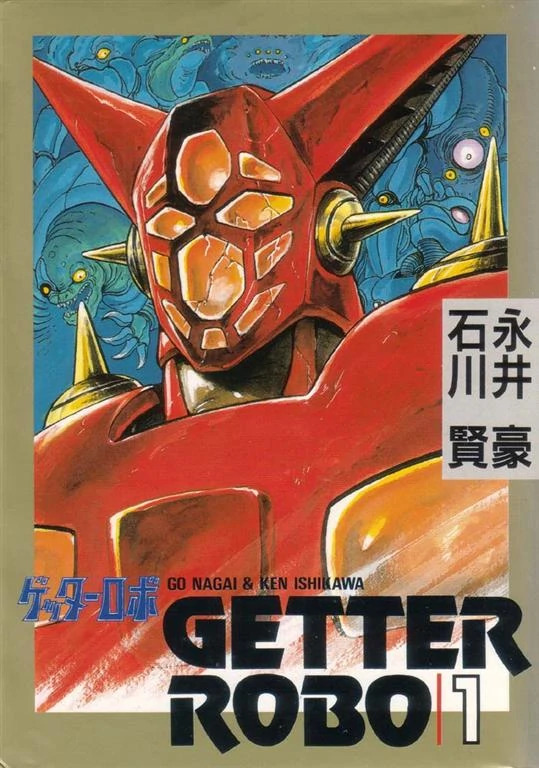
So, what is the story of the original Getter Robo Manga?
Well, the overall plot of the original manga is about the conflict between two sides of a conflict, as laid out rather well in it’s prologue chapter.
The first is our protagonists, the Saotome Institute of Japan, who’s leader and namesake has invented the titular giant mecha, the Getter Robo.
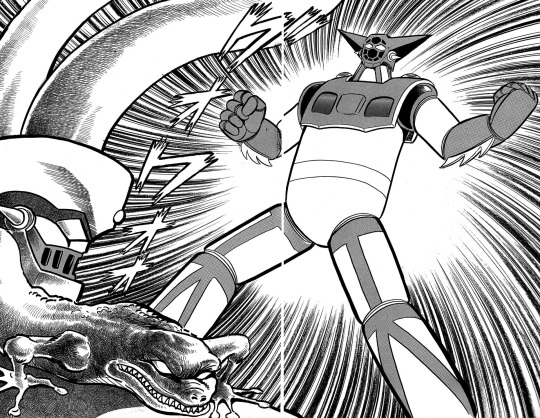
Powered by a revolutionary newly discovered form of energy called “Getter Energy”, this enormous metal behemoth is a fighting machine unlike any other.
This war machine was originally supposed to be used for space exploration, but due to necessity, it has instead been reworked into a fighting machine.
It’s only weakness is that it requires 3 different living pilots to operate it to draw upon its full strength.
Opposing the Saotome Institute, is the forces of the Dinosaur Empire
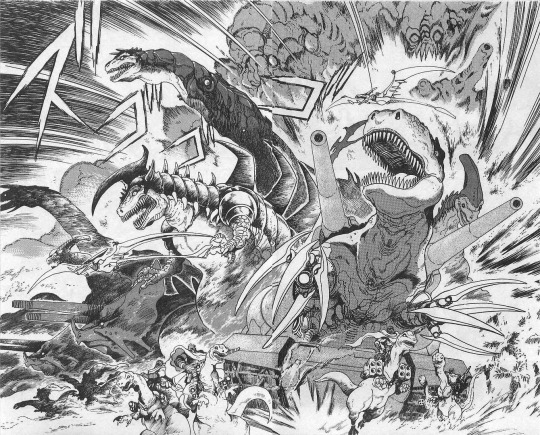
An empire of humanoid Sentient Dinosaurs that long ago was forced to flee the Earth’s surface after it was bombarded with a strange kind of energy from space that was deadly to their kind, their only way to survive being to use their incredible technology to hide on the only place on Earth where the rays couldn’t reach them. The Earth’s very core.
Now, after millions of years underground, and the rays that forced them beneath the earth to begin with having seemingly ceased, they have finally returned to reclaim the earth’s surface for their own. At it’s disposal, it has incredible technology, and giant cyborg dinosaur monster in it’s quest to wipe out the newcomers, the human race, to achieve total dominance over the Earth.
If you think this premise sounds very generic, and you’ve seen it in some form or another in countless other Mecha series, you are not wrong. Ancient evil group attacking the protagonists, and only the new giant robot can stop it, probably the biggest stock plot in mecha overall, having been done in everything from Neon Genesis Evangelion to Megas XLR in some form or another. The set pieces and details are different, but the overall plot is the same.
However, where Getter Robo fits into this, is that it was one of the first giant robot manga there was, and many, many of the tropes and ideas it pioneered would be used and imitated by its successors.
In fact, I would argue that Getter is the second most influential mecha series in history, only second after it’s big cousin, Mazinger Z.
However, we are not here to detail how it influenced the manga industry, but how Getter holds up on it’s own, and in this regard, despite having a plot that has been overused time, and time again by it’s successors, this isn’t really that much of a problem for Getter Robo. Because like any good Mecha series, Getter’s biggest strength is it’s cast of characters.
Starting off in chapter 1, we are introduced to the first of the Robot’s giant pilots.
Ryoma Nagare.

Each of the pilots of Getter Robo is given an introductory mini-arc to set them up, and Ryoma’s is easily the best of the 3.
We are introduced to the main character of most of the franchise at a very unusual spot to open a main character, especially for a Shonen protagonist.
At the end of a revenge story.
To put it bluntly, Ryoma does not start off this series as a particularly likeable, nor good person, as his introductory scene is him crashing a perfectly legal martial arts tournament and beating the everloving shit out of it’s referee, it’s participants, and the judges who arranged it.
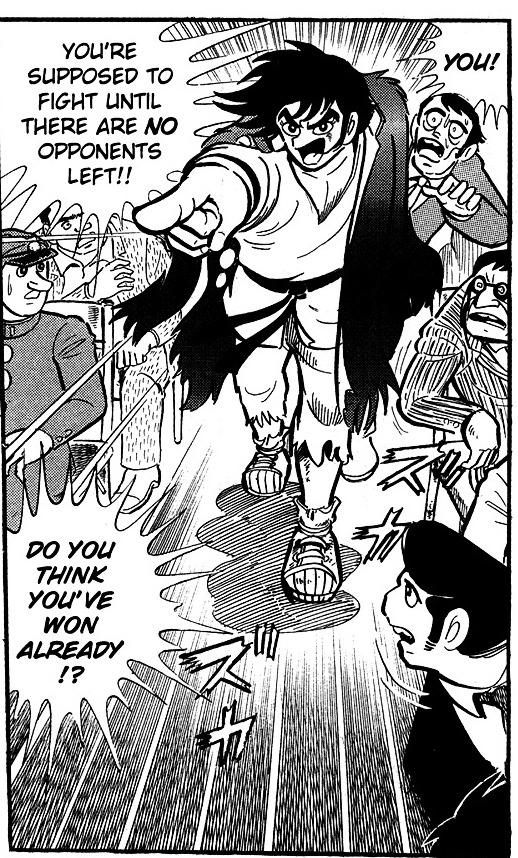

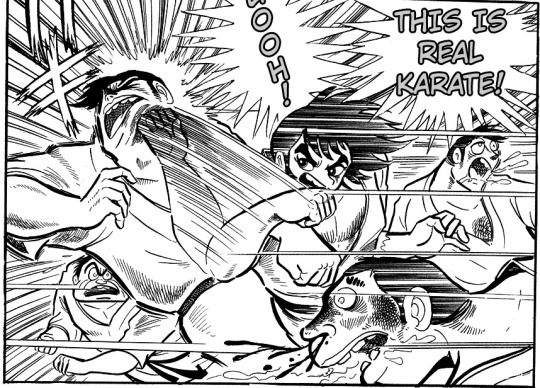
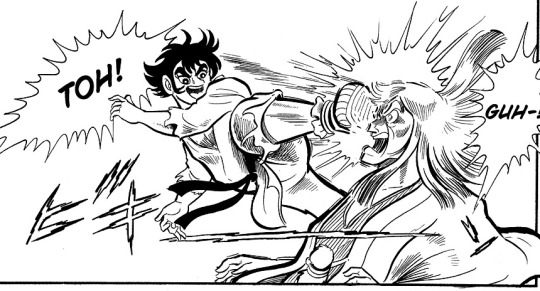
His reasons for doing all of this?

Revenge for his old man.
As it turns out, Ryoma had a massive beef with the arrangers for this contest, as his father, Ichigan Nagare was a pro karate champion back in the day, whose reputation was purposely destroyed by those arrangers.
Now he’s come to take revenge by utterly crushing their disciples on national television, to hammer in the point that his father’s martial arts was superior to theirs for all the world to see.
During this whole thing, we also get a very good look into how Ryoma thinks at this point in time.

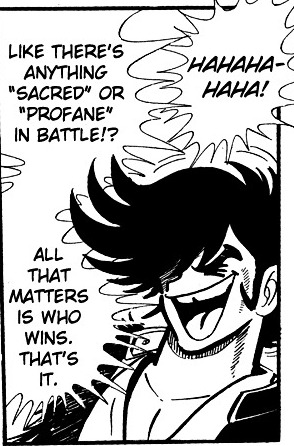
When the arranger tries to appeal to the “Sacredness” of the Sport to get him to stand down, Ryoma laughs in his face, proclaiming that there is nothing sacred about combat at all. The only thing that matters is who emerges as the victor.
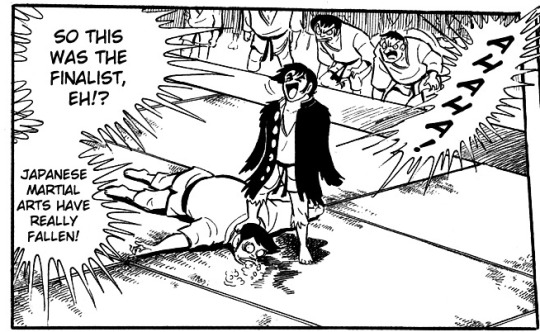
This is backed up by how he doesn’t show the least bit of compassion or honor to the first of the contestants he defeats, easily smashing him to the ground then gloating over him after having demonstrated the sheer difference in the combat prowess between the two of them.
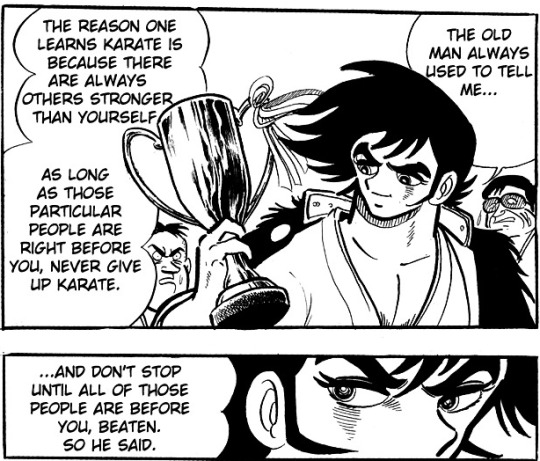
He is very blunt about the fact that he believes that one should pursue strength for strenght’s sake alone, and never stop until you have crushed anyone who stands before you. Always train to get stronger, and always seek out those who can challenge you and beat them too.
Might makes right.
This is a REALLY good introduction for showcasing Ryoma as a character. How he thinks, his immense near superhuman strength, his ruthlessness, his pride in his own strength.
It also ties in directly into the themes of this series, as this kind of thinking is essentially Evolution itself boiled down to it’s bare core. The survival of the strongest. What is the point of Evolution after all, if not this? Those with the traits to survive and thrive will do so, while those who cannot, will be crushed by those who can, who in turn will pass down what made them successful to begin with.
Of course that is not what the actual message of this series is, but it is a concept that this series is rather blunt about, and it’s not a coincidence that the most prominent of all the main characters of this series began his journey while believing wholeheartedly into that ideal.
All in all this scene is just great, and it sets up Ryoma really well, as well as making it clear that this is a boy who has a lot of growing to do as a person.
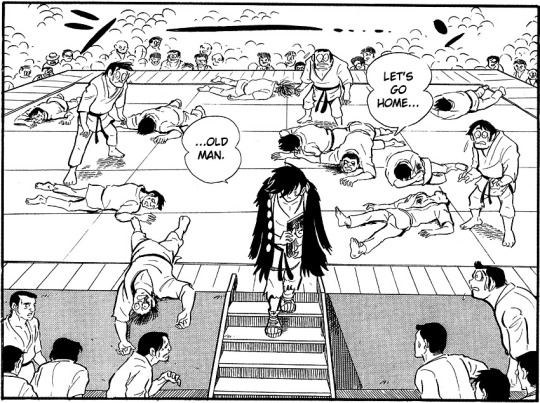
And so, having achieved his life’s work that he’s trained for for years and years, Ryoma nagare quietly leaves the arena, leaving behind a dozen bruised, battered and broken men on the ground.

Of course this display of power has not gone unnoticed, as in the audience were two men from the Saotome Institute who came here hoping to find someone strong enough to pilot their giant robot.
As it happened, they just found one that fit the bill rather spectacularly.
Then in the next scene we are showcased Ryoma’s home.
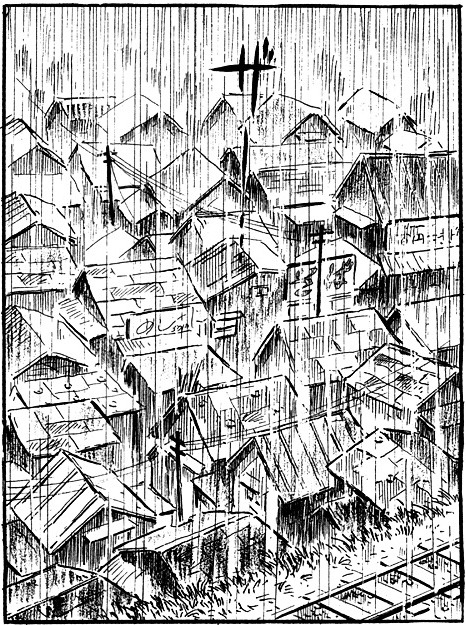
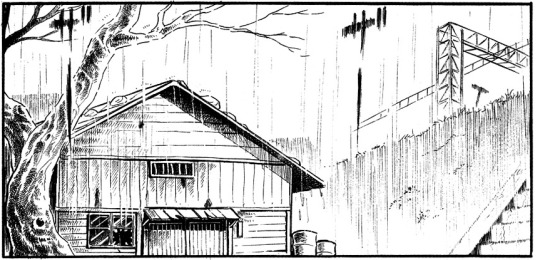
Ryoma Nagare, a fighting genius that at the tender age of 16-17 smashed the greatest karate practitioners in Japan with ease while being outnumbered a dozen to one, lives in a ramshackle part of town, in a rundown old building that has broken windows, a leaking roof, and can at best be called a ramshackle cottage.
It’s a rather brutal contrast to the sight of the prestigious, well made and maintained karate tournament building we were just in.

Inside we find the sight of something else rather unusual for a Shonen protagonist. Having now achieved his goals, and avenged his father’s memory, Ryoma is slowly starting to come to the realization that this has all been one giant waste of time. He hasn’t actually earned anything on this journey. His father is dead, he’s still poor, and his only belongings is this shitty building and the clothes on his back.
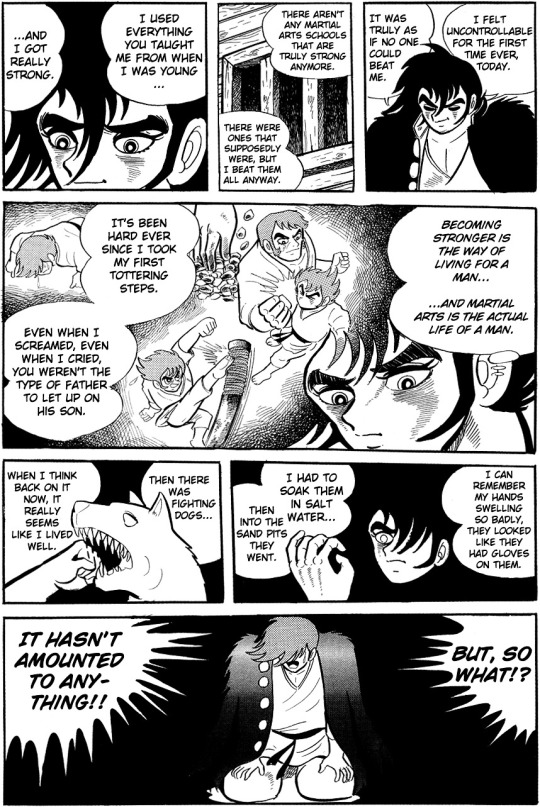
As we learn here, Ryoma has spent his entire life being trained in martial arts, to insane degrees even for an adult man, much less for a child. All for the purpose of one day doing what he did today, and avenging his father’s memory.
This scene really hammers in the fact that for all his ridiculous strength, Ryoma is a child, and he has a child’s way of looking at things.
He thinks back fondly on being pitted against stray dogs in death matches, and he reveals here that in his mind, this was all about “Redeeming” martial arts somehow, as if this display would really change anything in the grand scheme of things within the sport.
It wasn’t of course. This was all about revenge. Everything Ryoma ever trained for was for this moment, this moment of what should have been absolute and total triumph as he achieved a truly spectacular victory and proved his father’s fighting style the best in all the land and he has proven that he himself is the strongest fighter in all Japan.
Instead he is coming to the realization that so many people that wasted their lives on vengeance have come to over the years. That it was all a giant waste of time.
Revenge is a suckers game.
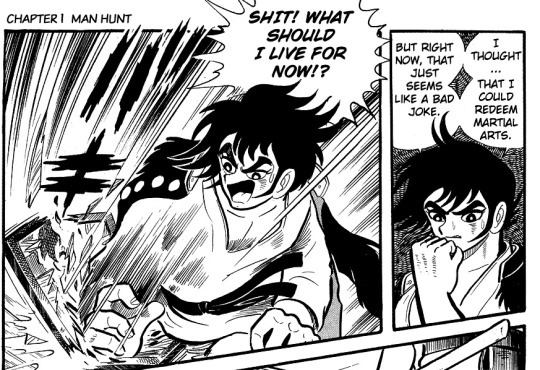
Having achieved his goals, Ryoma has found them to be completely empty, and has nowhere to go. This is a really fascinating way to open up a character arc, as usually a character that learns the lesson that David Xanatos knew so well, happens either at the end, or somewhere later down their line. Ryoma however, learns it in the very first chapter, and now has to find something else to live for.
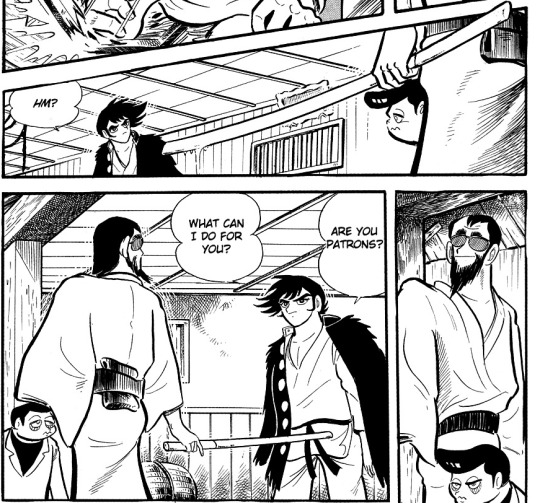
However, his soul searching is then interrupted by a few gentlemen from the Saotome institute.

Who immediately tries to kill him.
Now before I discuss the next part, I wanna praise this overall scene, because it really works great within the context of this chapter.
Ryoma has been introduced as a massive asshole, who firmly believes in the mantra of Might makes right, and he doesn’t feel any regret at having brutalized a dozen of innocent people, just the fact that he realizes that there was no real satisfaction to be had from it. Now the other shoe drops, and HE is attacked in his own home, completely unprovoked for reasons that frankly he has no personal involvement in on his own side. While this attack does have an in universe reason behind it, it main purpose is that it serves as a nice cathartic moment for the reader, as while he’s never going to legally punished for what just happened at the tournament, he is punished by the narrative for his actions, which is something i’ve seen far, far too many stories do over the years fail to do with asshole protagonists.
It also serves to put Ryoma’s current belief in Might Makes Right to the test. After all, aren’t these men doing exactly what he said that those who practice martial arts should do? Seek out those stronger than them, then crush them.
All of this makes it a shame that it is horribly undercut by the one, genuine stain on the original manga. Namely that one of the attackers is this guy.
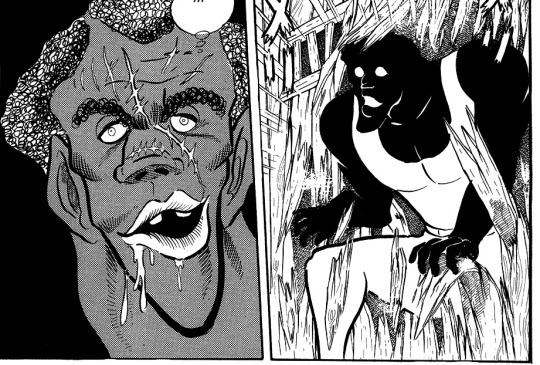
And it’s at this moment you realise, oh yeah, this was made in 1970’s Japan. The unfortunate fact is that Mangaka of this period generally based their depiction of black people on early American comics(Which had plenty of this kind of artwork), and Ken Ishikawa was unfortunately not an exception to this rule.
He would THANKFULLY not repeat anything like this later down the line(his depiction of black people is far more natural and realistic in later manga), but hot damn is it both uncomfortable and distracting to read the pages with this guy. And it’s a real shame too, because frankly, not only is the following fight scene very good as a narrative punishment for Ryoma, but it’s just a good fight scene in general.
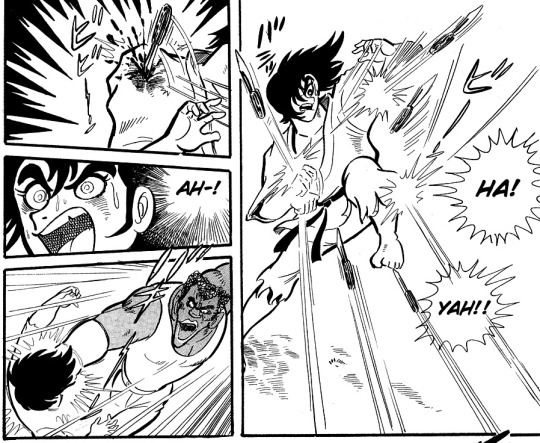
Unlike the Tournament fight, which was mainly a beatdown to establish Ryoma’s ridiculous strength, this is an actual fight, which showcases Ishikawa’s ability to draw energetic, exciting fight scenes where action flows very naturally.
It also shows that for the kind of ridiculous strength Ryoma possess, he isn’t some superhuman, as early in the brawls he’s heavily wounded by the rather mundanity of taking a throwing knife to the shoulder. This is in general something that makes action if Getter Robo stand out from other shonen series too. When characters, or Robots for that matter, takes hits, they rarely shrug them off with no problem, instead taking real, genuine damage that doesn't just instantly go away. They might power through them, but that isn’t the same as them disappearing into the ether.

In any case, the battle ends up outside the house when Ryoma is thrown through the wall.
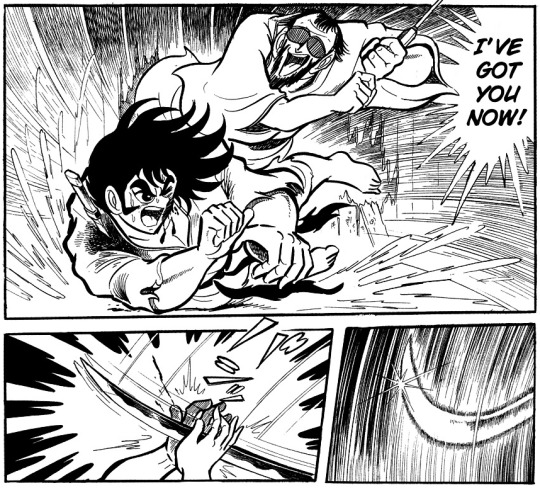
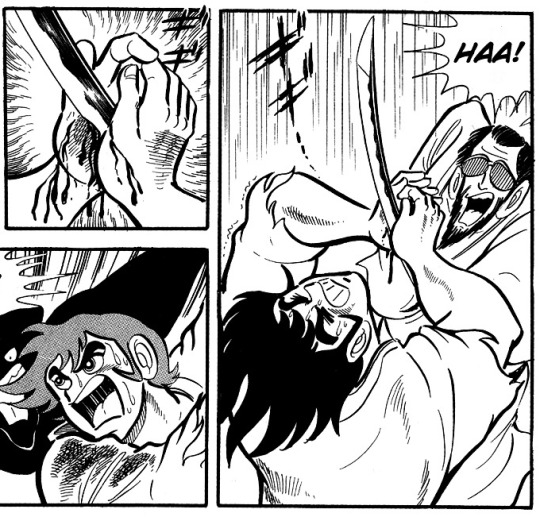
He’s then forced to do the classic, catch the blade between the palms of his hands trope, which is depicted much more believable than most cases I’ve seen, as despite succeeding, it still left him bleeding from those palms.
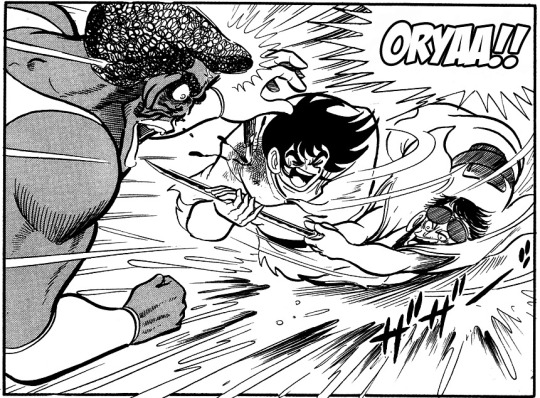
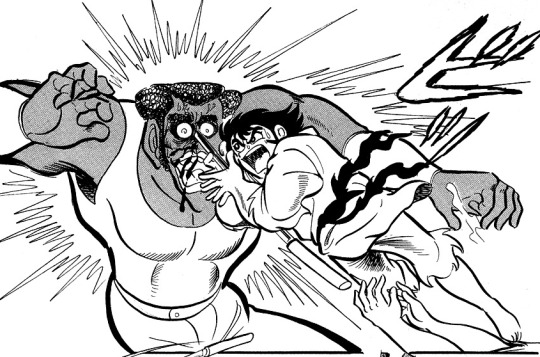
Ryoma then redirects the blade into the big guy who is attacking him from behind, killing him. I really love how the artwork sells that this is a desperate move on Ryoma’s part. He is genuinely fighting for his life here, and he’s pulling out every trick he has to to win despite his wounds.
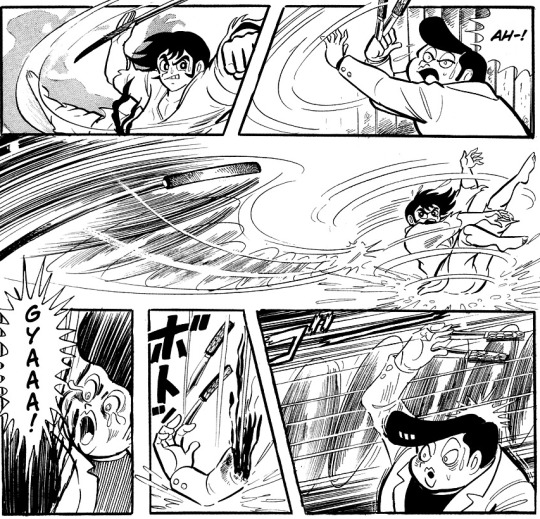
He then follows that up by ripping the blade out, and throwing it at the knife thrower guy. I also like that after doing so, he immediately falls flat on his ass, in a rather realistic manner(he is fighting in the rain after all, so the ground is undoubtedly pretty slippery.), while also showcasing the force of the throw. My only main complaint is that for this one panel Ken forgot to include the wound and the knife on his shoulder, as I think it would really sell just how desperate Ryoma is here if we’re visually reminded in the moment that, oh yeah, he’s powering through and using the arm whose shoulder has a knife in it to to throw this thing.
Thankfully, that missed opportunity for visual grittiness is more than made up for by the next part.
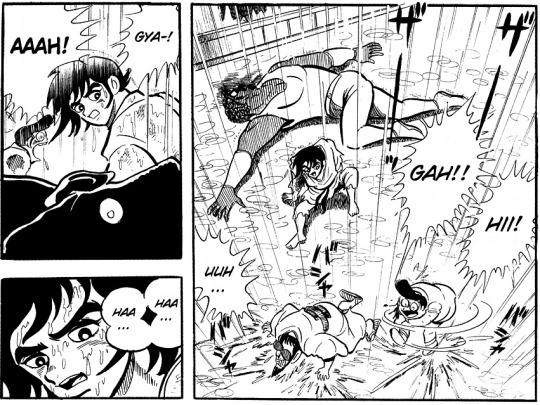
Having now effectively won the battle(I think the swordsman broke his foot in the fall, at least that’s how it looks), Ryoma suddenly realises that, holy shit, he just killed someone. The contrast between here and how he looked as he challenged the tournament fighters couldn’t be more different. The cooky, arrogant youth is completely gone, and you're reminded that Ryoma is just a kid. A kid who just had to kill someone. The bravado is completely gone, leaving only a kid who is tired, confused, in pain, and probably pretty scared.
He is then approached by the man who just had 3 grown ass men jump and attack him, Dr. Saotome.
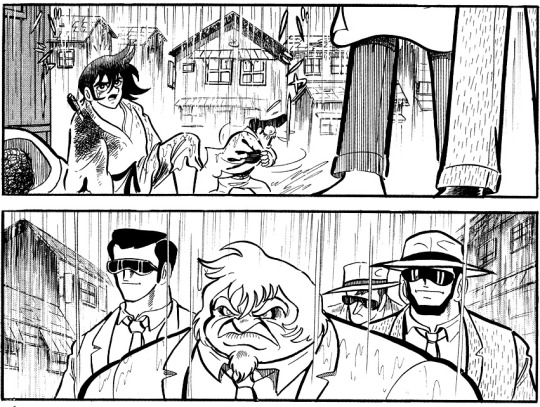
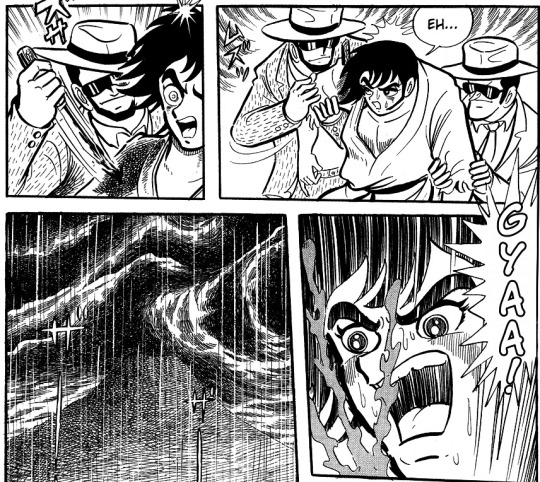
Wounded, and mentally exchausted as he is, he is in no position to argue as Saotome declares that Ryoma is what he’s been looking for, and as one of his men rips the knife out of his shoulder, Ryoma screams before losing consciousness from the pain. Afterwards he is dragged into a car, and bandaged up.
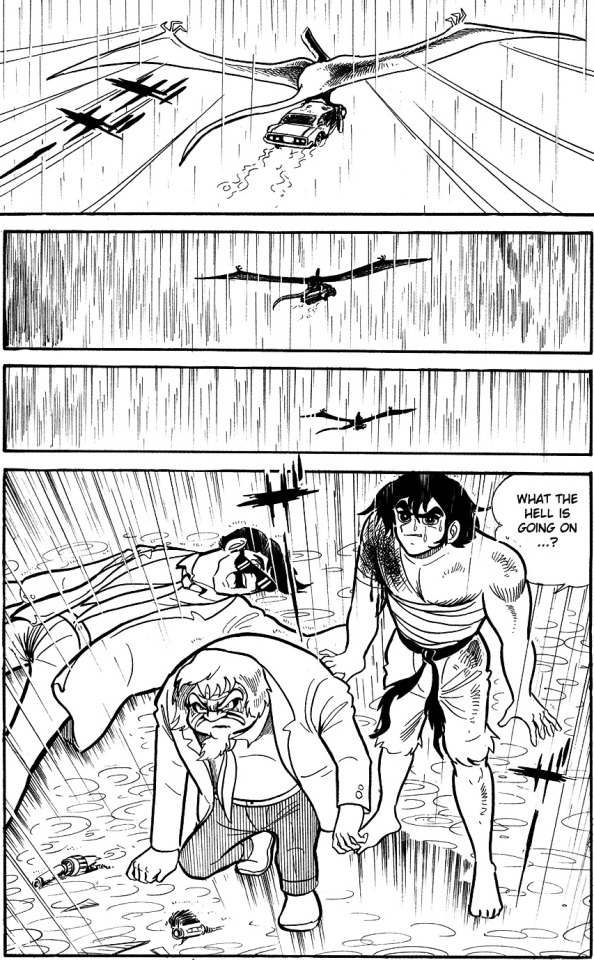
Then as they're driving, the’re attacked by a giant flying dinosaur that grabs unto the car and flies away with it, Ryoma and Saotome barely managing to get out in time, alongside one of Saotome’s unlucky goons who breaks his neck in the fall.
And so ends Chapter one of Getter Robo.
All in all, other than the horribly racist black guy, this is a really good first chapter, that sets up Ryoma Nagare really, really well, showcasing his way of thinking, his origin, and where he needs to grow, while also showcasing his ludicrous strength, and that he is fully capable of going balls to the wall to win a fight, which will be showcased many, many times in this series. It also ends on a reminder of the fact that oh yeah, this is a series about one side vs dinosaurs, as Ryoma gets his first introduction into the enemy he will be fighting time, and again in this manga. It also gives a distinct first impression of just how ruthless Saotome is, as he is perfectly willing to send 3 dangerous goons on a teenager just to test his prowess in battle, which is absolutely going to come into play in future chapters.
All in all, it’s a good start. Not an amazing beginning, but certainly a good introduction to our first main character.
40 notes
·
View notes
Note
For manga fans, Masashi Kishimoto and Naruto needs no introduction. It is simply one of the most popular manga series ever created, not just in Japan, but throughout the world.
Masashi Kishimoto first drew Naruto as a one-shot manga in 1997, then it was added as a weekly series to Weekly Shonen Jump in 1999. Kishimoto's story of a plucky young ninja orphan who has the power of a nine-tailed fox god locked in his body and his path from being a brat to a powerful ninja leader. It is an epic tale that spans over 72 volumes and 700 chapters, has been adapted as an anime TV series and movies, video games, and novels, and is one of the best-selling books (not just comics or manga) ever.
For Masashi Kishimoto's first visit to North America, much less New York City for New York Comic-Con, Viz Media arranged several special opportunities for fans to meet and listen to the creator of Naruto speak about his comics, his creations, and his future plans. ANN's coverage is in 2 parts:
On Wednesday night, before the start of New York Comic-Con, Kishimoto was a special guest at the Apple Store in downtown NYC. This was a ticketed, intimate event that less than 100 people were able to attend and see in person. The audio of the event will be available as a podcast from Apple's iTunes Apple Store podcasts page.
The moderator for this event was Christopher Butcher, the Director of the Toronto Comic Arts Festival (TCAF). He was joined on stage by Jo Otsuki, the editor for Naruto from Weekly Shonen Jump magazine, and Mari Morimoto, the translator for this event, and also the translator for Viz Media's English editions of the Naruto manga.
While no photos were allowed for these events, Kishimoto is a slim man who just recently turned 40. He initially seems a bit quiet, but is friendly and easy-going. He cracked a few jokes with fans, and seems to take his great fame and success in stride.
Butcher began by asked Kishimoto whether he was aware of the impact that Naruto has had upon fans worldwide, and his role as an "ambassador of Japan" to North America. Kishimoto laughed, saying that he thought it was kind of amazing that fans in North America were interested in Japanese manga and culture, and that he thought most people would be more familiar with "Naruto" (spiral fishcake) as an ingredient in ramen rather than Naruto the boy ninja.
Kishimoto's humble perspective perhaps comes from his early efforts to create a manga for Jump. He explained that he had tried several times to create a hit manga, exploring everything from sci-fi to action to sports manga. After many misses, Kishimoto said his editor encouraged him to give it one more try. That last try was the one-shot manga that eventually became the weekly series Naruto that we know and love today.
Butcher also marveled at Kishimoto's cinematic style of drawing. Kishimoto explained that his style was influenced by manga masters, including Akira Toriyama (Dragon Ball), Katsuhiro Otomo (Akira) and Hiroaki Samura (Blade of the Immortal). Kishimoto expressed admiration for Star Wars, and American comics movies like Spider-Man, Iron Man, and Batman.
He also talked about his friendly rivalry with Eiichiro Oda, the creator of One Piece.
"One Piece debuted about a year earlier than Naruto did, even though we're the same age. He beat me to it. I was very envious in the beginning and yet, at the same time, I wanted to not only be like him, but I wanted to surpass him. In some ways I feel like the reason Naruto was able to be published and was able to succeed was because of One Piece." He continued, "Perhaps we both kind of supported and bolstered each other over the years and lead to both of our successes because we had that rivalry. When one of us did something, the other one had to out do the other, and that kept both series going."
Kishimoto then described his creative process, and revealed that the entire process, from sketches and rough storyboards to finished artwork is all done by hand, not digital processes.
"I'm actually quite analog. I don't draw manga digital yet at all. We do get these sticker sheets with different tone and shades. It's not just me doing it; my assistants and I will get together and we have fun putting on the tones manually."
ut Kishimoto had this bit of advice for up and coming comics creators:
"I don't recommend the manual method anymore. It's quite costly and it's quite a lot of work and takes a lot of time. I definitely recommend, for those of you who are just getting started or are not yet started, to go digital."
However, he also warned of the limits of digital tools for comics creation.
"There's no software out there, no digital technology is going to help you make a better story," he said.
Bakuman., the manga about making manga by Tsugumi Ohba and Takeshi Obata was also mentioned in conversation. When asked if Bakuman. was an accurate representation of what it's like to be a Shonen Jump manga creator, Kishimoto replied, 'I definitely had the experience of having an editor yell at me, about deadlines especially. I guess about 99% of it might be true." So what's the 1% that's not true? "I really don't think it's feasible for high school students to really make it professionally and still go to school at the same time! But certainly I had to work even while I was sick."
So what is Kishimoto doing during his well-deserved break from the weekly manga-making grind? For one thing, he's minding his health, by taking up jogging and weight training. He's also been spending time reconnecting with his family. He mentioned that the Boruto movie is inspired in part by his relationship with his sons. Kishimoto confirmed that his next manga project will probably be a sci-fi story, but opted to not share more details because he didn't want anyone else to take his idea and run with it before him.
After a lively Q and A with audience members, the evening came to an end. Kishimoto was whisked away. The following exclusive interview happened the day after the first event at the Apple Store in SoHo, but before his appearance before a packed house of over 2,000 fans at New York Comic-Con.
With the help of translator Mari Morimoto (who also translated the Viz Media edition of Naruto), and Jo Otsuki, Kishimoto's editor from Weekly Shonen Jump, we talked about Kishimoto's reactions to his first encounters with his overseas fans, what does and doesn't exist in Naruto's world, how Boruto was influenced by his relationship with his sons, and he offers a few hints at his next series in the works.
I know this is your first trip to an overseas comics event -- How did it feel to get a taste of your overseas fans' enthusiasm for your work at the Apple Store yesterday, and so far today at New York Comic-Con? Masashi Kishimoto: It was a very mystical experience, a very interesting experience!
I know you must know that Naruto is very popular all over the world – but as I listened to you talk at the Apple Store last night, I got the sense that this didn't really feel real to you. What do you think now that you've met some of your fans? Of course, I have been told that it's popular overseas, but it really hasn't felt real to me until now. Even now, it's still hasn't quite hit me yet. I feel like even the people telling me that there's this many people wanting to see me, I feel like it might've been a setup?
(laughs) What do you mean by that? Kind of like when there's a studio audience when you're filming a sitcom?
You mean like a fake audience? A planted audience, yes.
Oh my goodness! (laughs) When I told people that I would be doing this interview, I got so many comments like, "I'm so jealous that you get to even be in the same atmosphere as Kishimoto-sensei!" I really don't feel like it's sunk in yet, even now.
Wow. Well, you'll definitely get a taste of it today at your afternoon event today at NYCC! So I wanted to follow up with some of the things you said about your artistic influences from your chat at the Apple Store last night. You especially mentioned Dragon Ball by Akira Toriyama, Akira by Katsuhiro Otomo, and Blade of the Immortal by Hiroaki Samura. What do you take from their work? What do you love about their work?
I would say I've probably picked up a little bit from each of them, and perhaps a little bit different thing from each of them. For example, with Dragon Ball, I was reading that when I was in grade school. What Dragon Ball taught me is what was fun about manga, what makes a fun story in manga. In fact, I was reading it as it was coming out in weekly installments in Weekly Shonen Jump, so it really taught me what entertainment is and how to keep an audience captivated—and of course the art influenced me as well.
What did you learn from reading Hiroaki Samura-sensei's work? I think Samura-sensei really taught me about the craft of manga making, in terms of what's cool. Especially in terms of splash scenes, he really taught me the importance of splash scenes. In his splash page scenes, a lot of times he doesn't focus on the faces of the characters – he usually focuses on their hands. He taught me how one can focus on the hands and how important expressions using just hands can be.
Oh, that's fascinating. This also brings up an interesting question about the world of Naruto -- Blade of the Immortal is a very traditional Japanese samurai story, while your ninja world is very fantastical. How did you come up with that? So of course, a realistic ninja is someone who wears all black with only the eyes visible, kind of lurks in the shadows, and they are assassins. That's cool in its own way, but it's not necessarily appropriate or really makes up for a shonen manga series. That kind of story, it would be a different genre. So I was thinking about what would be appropriate for not only a shonen manga series, but a Jump shonen manga series. I figured I wanted to take a polar opposite approach, and portray this character who wears orange.
(laughs) Yeah! I was gonna say that Naruto's bright orange outfit isn't very stealthy for a ninja assassin! It's an orange jumpsuit, and Naruto goes 'Hey, I'm here!' Which is totally opposite of how a ninja should behave! It's a paradox. But I figured, 'Why not make this another type of real ninja?' Of course, I had some hardcore ninja fans who were like, 'Dude, get lost.' (laughs) They were really upset because this is not how ninjas are supposed to be!
Another thing that's interesting about Naruto's world is that there's technology, like ways to view videos, communicate over long distances – it's definitely not something that exists in traditional samurai-era Japan, but it's not a typical 'modern' Japan either. What definitely does NOT exist in Naruto's world? It would actually take too long to really go nitty-gritty into details, but for example: one of the things I focused on was that anything that's NOT possible to recreate, or to do, using ninjustu, ninja skills, I would not develop for Naruto's world. So no cars. Because they have shuriken, the throwing stars, there's no guns either. So there were certain things I had clearly in my head that I didn't want to have available in their worldview.
Mari Morimoto (translator): So I brought up the fact that in the Seventh Hokage and the Scarlet Spring sequel story, there's that one line when Naruto complains about how Sasuke's so analog, and Shikamaru's says, "Oh, but he goes to areas where you can't charge anything."I asked Kishimoto-sensei about that and he said, 'Well, you know, I wanted to show that time had passed. So some things may have developed in the intervening time between the last chapter of Naruto and fifteen years later when the Seventh Hokage story happens. Also, there's the fact that the story is set during a time of peace, so there's now more money available, because the funds that were being pushed into the war can now be used for things like developing technology.
That would be interesting to read! With Naruto, you've created a very rich universe with many characters, and you just did a Seventh Hokage and the Scarlet Spring side story, the Boruto movie, which you wrote the screenplay for, and there's also the Kakashi Hiden side-story novel that Viz Media is also publishing. That's a lot to enjoy, but are these sequel stories the last of your Naruto stories, or do you think there's more stories left to tell? Or after 15 years, are you just DONE with Naruto? (laughs)
There are infinite possibilities right now. If I decide that I want to do more Naruto stories, perhaps I will, perhaps I won't. That said, there is nothing firmly in the works at this time. Just that there is always the possibility…
I see! So I guess Naruto fans can keep their hopes alive to see more someday, maybe. As I mentioned, Naruto has many, many wonderful characters. But were there characters in Naruto that surprised you that were very popular with fans? Rock Lee.
Ah, right! So did you decide to include Rock Lee in the story more because he became so popular? No necessarily. It's just what I heard. It kind of surprised me how popular he was, but it didn't necessarily lead to more plotlines with him in it, or anything like that. That's not to say that I didn't consider writing him in more or creating more stories about him, but the timing was never right, so I never had the opportunity.
Speaking of new characters, I also noticed as the story evolved, there were more multi-cultural characters introduced to the story, like Killer Bee. Can you talk a little bit about why you decided to do that? When I started expanding on the world, especially through introducing other ninja villages, the very nature of doing that kind of forced me to widen the perspective. I wouldn't say it was necessarily a deliberate decision, but I was definitely conscious of the fact that if I wanted to have my Naruto world reflect actual society more, then it might be easier for fans to accept, to see, other cultures or races as well. So while it wasn't necessarily an outright deliberate decision, I think I was conscious of the fact that I wanted Naruto's world to reflect, at least a little bit, the world at large.
As these characters appeared in Naruto, I noticed that lot of black and Latino cosplayers were very excited to see these characters, to have characters that they could dress up as that they could relate to.
(big smile) That makes me happy to hear that as well!
Did you expect such a divided reaction (in the U.S. at least) when you revealed whom Naruto marries in the future?
I actually didn't realize I caused such controversy.
Really? You had no idea?
Mari Morimoto: So the fans wanted Naruto to get together with Sakura?
Well, there's definitely camps of fans who felt that way, and there were also those that were very happy he ended up with Hinata. But there were quite passionate opinions on both sides! I almost caused a rift in my own household too, because my wife was very upset also that Naruto didn't get together with Sakura. In fact, she complained quite vehemently to me!
Jo Otsuki: Quite few of the female staff at Studio Pierrot that produces the anime, apparently were also upset.
Whoah. So how did you handle that, especially with your wife? I tried to defuse the situation by assuring my wife that SHE was actually the model for Hinata. (laughs)
As you were saying that, I thought, I wonder if your family life was more like Hinata and Naruto's family or Sasuke and Sakura's? (everyone laughs)
Masashi Kishiimoto: Well… it might not actually be like either. My wife is quite strong as well, she's a strong character.
Oh, so kind of like Sakura! So I think my wife might secretly realize that Hinata wasn't really the model for her… (laughs)
Did you decide this early on, that Hinata and Naruto would get together in the end, or when…?
From the middle, actually.
Aw, that's nice. So you obviously care a lot about these characters and this story. It took up over 15 years of your life! Was it difficult to decide to end Naruto? It was kind of decided—not necessarily early on, but I knew that it was going to be concluded soon. So it's not like that decision was unexpected. However, it took a while to smooth out the story to let it conclude the way that I want it to.
It was a slightly bumpy road, mainly because I wanted one of the themes of the end to be Naruto forgiving Sasuke. I wanted to make sure the intervening story lead naturally to that in a realistic way to make it plausible. Because if one minute they're fighting and then 'Oh, I forgive you!' would be weird. So definitely there were little bumps on the way to getting there.
Deb Aoki: Can you share an example of a bump that you ran into along the way toward the ending?
It would be the Pain Arc. It was difficult, because it was the very first time Naruto truly forgives his enemy. I didn't want the conclusion of their confrontation to be in battle, but through talking, so to bring that all about was quite difficult.
So now that Naruto has ended, you've hinted in other interviews that you're considering creating a sci-fi series next. You've mentioned that you like Star Wars, but are there other sci-fi series that you like? It's hard for me to narrow it down to one or two. I actually like quite a bit of sci-fi movies, for example, Elysium and Chappie, two films directed by South African Neill Blomkamp.
Oh, what do you like about these movies? Just the sense of this director, Blomkamp's cinematic view. I think what I like about it is there's still elements of real society within the movie and it's kind of merged with the fantastic elements -- it's really meshed. It picks up on current issues we're facing and expands further on it.
You definitely deserve some time off after so many years of drawing a weekly manga series, but when can we expect to see your next manga series debut? Perhaps after my children finally acknowledge what I'm doing and acknowledge me… acknowledge the work I've done!
What? Really? They don't now?
Naruto took up so much of my time that I didn't really get to spend quality time with my kids. It's only recently that they really accepted my presence. So I think I might have to wait until my children give me permission to work on my next series.
Wow. Well, that's very important too, so I totally understand. I know that fans who'll get to see you at your New York appearances are very fortunate to have this chance to be here for your first overseas trip to a comics event. That said, you have so many fans around the world who are hoping to meet you some day, see you visit their cities or countries. Because these fans would have loved to have met you but didn't have a chance to be here this weekend, do you have any messages for them?
First and foremost, I wanted to thank all my fans out there for reading Naruto and for loving Naruto so much. It really is gratifying for me too. But despite how I answered the last one, I wanted to say it might not be so long until my next series to appear as my answer implied! After I spend enough time with my kids, they might be like typical kids and say stuff like, 'Okay Dad, you can go away now.' (laughs) So you might see my next series in the not-too-distant future!
Thank you – and I hope we will see you again soon at another event in the near future!
is true?
To start off, for god sakes don't post the whole thing, take an extract or just give me the link, but this is way to long for an ask. I don't even know which bit you are on about.
Yes it is true, but lacks some details that Kishimoto in later interviews. For example Kishimoto definitely always planned NaruHina from the start, but he intentionally made NaruSaku a red herring.

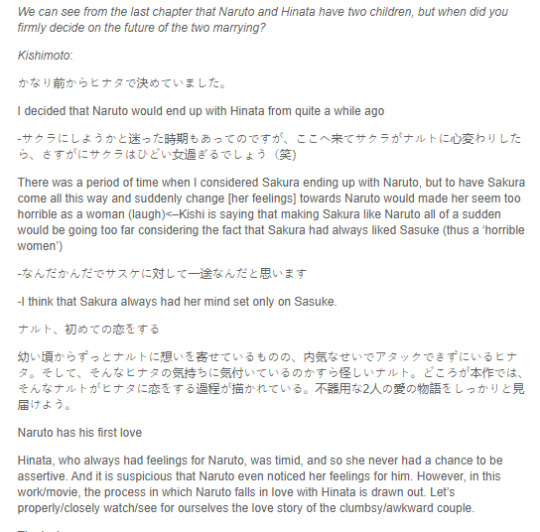

Kishimoto's response

Now if you consider the timeframe of when Kishimoto did the red herrings you would realise that mainly happen during and around the Tenchi Bridge Reconnaissance Mission which covers chapters 282 to 310 of the manga which is roughly the half way point of the whole series and the half way point of the plot since it happens in the second arc of part 2.
As you can tell after that arc there isn't anymore serious NaruSaku red herrings. Kishimoto did them planning to do a love tringle, though he did briefly consider NaruSaku you can tell his end game was always NaruHina from start. Hence why he said the middle in that interview cause it was period where he did consider other options even though he originally already planned NaruHina, hence he made the final say to stick to that original decision at that point of the manga.
Even the bits about there being parallels between Kushina and Sakura while a red herring weren't meant to be taken seriously as in the Pain arc when Hinata confesses was when NaruHina got truly cemented and following that was the final nail in the coffin for NaruSaku with Sakura's fake confession being rejected.
Further proof of this is that in the same interview Kishimoto brings up that Hinata always supported and acknowledged Naruto. From the start it was obvious Hinata liked Naruto for who he really is Kishimoto made her that exact way. It is impossible for him to have made Hinata like that unless he originally intended for her to be the love interest.

Naruto is a long manga series and like with all long series the author will at times have to or need to consider making changes from their original plan. So yes while the interview is true it isn't the whole truth as in later interviews Kishimoto expands on the answer and we can tell by the context which time frame he is on about, Kishimoto did decide on NaruHina early on, he did however also consider changing that in the middle which led to him deciding to commit with his original plan for NaruHina.
6 notes
·
View notes
Text
Exe Characters as Magia Record Units Part 2: Electric Boogaloo
(Ok disclaimer I had this draft half done and then tumblr just... lost it cause I hit the wrong key. So this is attempt two, and I might go back and change stuff later when I remember what info was lost.)
Ok I lied I’m not gonna wait to do the rest of these.
Yesterday I posted my prompt response for day 18 of Magitober, an Inktober-style drawing challenge for Magia Record. Day 18′s prompt was ‘crossover’, so I decided to do something with Exe, because of course I did. I decided to rewrite the main Cross Fusion trio from the anime into playable magireco units, and started with Netto. Here I’m gonna put my rewrites for the other two, Enzan and Laika. Despite how they act in canon, I’m designing their units to function as a cohesive team.
(Even longer post than last time warning ahead)
First, let’s start with the egghead. I actually began working on Enzan’s rewrite first, because for some reason Blues just screams ‘blast gorilla’ to me. I dunno, but I went with it. Onto Stats!
Ijuuin Enzan (Cross Fusion Ver.)
Element: Flame
Type: Attack
Growth Pattern: Balance
Disks: ABBBC
Now, magireco is very particular about elemental alignments, in that every character must have one, even if it’s not particularly relevant to them. Null element, or ‘Void’ as it’s called in-game, is reserved to characters who have made a very specific type of wish. Obviously, none of the Fusion trio are meguca, hell, they’re not even magical girls (boys?), so that makes an issue for a character that was originally null element. Fortunately, there’s an out here. Blues doesn’t have any elemental association, but Enzan sorta does, with his name. It’s spelled “炎山” in kanji, and hey would you look at that, the first kanji is the term for ‘flame’! Problem solved!
Connect: Take My Strength
Blast Damage Up, Defense Up
Blues is tankier than Rock is, and has a shield in the games, so I think it’s ok to give Defense Up here. As for the name, Blues says a similar line in Axess 27, while forcing a Soul Unison to complete. I get that it’d be more relevant to give something that Enzan says, but I can’t think of anything there.
Magia: Sonic Boom
Damage a Vertical Line, Blast Damage Up (Self/ 2 turns), Chance to Stun (Enemies targeted/ 1 turn)
The stun chance is there because, realistically, an actual sonic boom would disorient someone, since it’d A) kill their hearing, and B) surprise the living daylights outta them.
Second Magia: Cursed Blade Muramasa
Strengthened Damage a Vertical Line as HP is Lower, Blast Damage Up (Self/ 3 turns), Attack Up (Self/ 3 turns), Defense Down (Self/ 1 turn)
To my knowledge, I believe the Muramasa sword does show up in the anime; however, I don’t remember that version. I do remember the manga’s version quite well, though, since there Blues wielded the sword as his main weapon from volume 7-ish on. The manga version could be ‘activated’ to deal a crapton more damage than usual -- however, to force that power up, Blues would have to sustain damage, and quite a lot of it. I’ve emulated this here with the ‘more damage as HP lowers’ effect, which at the moment is only seen on Ren and Yukika in-game. As for the defense down, I mean, if you took that much damage, you’d be less combat-ready, yeah? Plus, the ‘give-and-take’ mechanic is always fun.
Like last time, I’ll come back to Spirit Enhancement once everyone’s kits are done. Moving on!
Last up we have the sniper. Now, I knew immediately that a magia build did not fit Laika (or Search), but neither did a blast kit. I eventually decided that emphasizing charge made sense here, since a sniper would specialize in shooting down a target in one hit, similar to how charge-blast strats work. Onto stats!
Laika (Cross Fusion Ver.)
Element: Forest
Type: Support
Growth Type: Attack/Defense
Disks: ABBCC
Our only non-gorilla unit! I’m modeling Laika’s build here off of ‘honorary Chargius’ units that are based around charge but are not charge gorillas, like Sis Momoko or Yaito’s long-lost cousin Hagumu. Search easily has the most armor of the three navis, and therefore, Laika doesn’t get to be an Attack type. (Also I needed a defensive unit to round things out.) He gets the forest element, because his clothing/amor is green and I can’t think of any other elemental reference here.
Connect: (I can’t think of a name here oops-)
Damage Up, Guaranteed Anti-Evade, Damage after Charge Up
Yeah, I couldn’t think of a name. If you’ve got one, lemme know.
Magia: Circle Gun
Damage 1 Enemy, Damage Up (Self/ 1 turn), Guaranteed Anti-evade (Allies/ 2 turns), Damage after Charge Up (Allies/ 1 turn)
Circle Gun was the name of Search’s attack in the games, if I remember correctly?
Second Magia: Satellite Ray*
Damage 4 Random Enemies, Damage Up (Self/ 2 turns), Guaranteed Anti-Evade (Allies/ 3 turns), Chance to Darkness (Enemies targeted/ 1 turn)
*I don’t remember if this was exactly what this attack was called, but I’m going with it unless I’m corrected.
Since this attack involved what I could only assume were lasers, I assumed that anybody not killed by it would probably be somewhat blinded by the flash anyways. I removed the Damage after Charge Up to make room for it. Since Laika’s a Support type here with only one Accele disk, he’s not gonna be using magia often, if at all. As a result, it’s not that critical that the second magia be a stronger version of the normal magia. Also I couldn’t think of anything else to use here.
Again, I’ll get to SE in a separate post, because this was a lot of writing and I don’t want to make this any longer. I’ll add the link here when that post is done.
#Y'ALL this took FOREVER#mostly cause tumblr crashed#also full disclaimer i still haven't finished the anime...#magia record#rockman exe#ijuuin enzan#exe laika#no drawings this time cause this isn't part of magitober and also im tried#y'all know what they look like#rapo rambles
11 notes
·
View notes